






Great people, great service, and great products from companies like Siemens. This is how we create customers for life. One customer at a time.

Heating and Cooling
• Air Distribution
• Controls
• HVAC Equipment
• Hydronics & Steam
• Parts
• NEBB TAB Service
• Boilers
• Controls
• Mechanical
Building automation makes facilities more comfortable while also saving energy and money. As the premier building HVAC, controls, and service company in Arkansas, we know building automation inside and out. We offer heating and cooling solutions to architects, engineers, contractors, and building owners that both do the job and fit the budget.
To learn more, give us a call at 501.374.5420 or visit us online at www.powers-hvac.com.

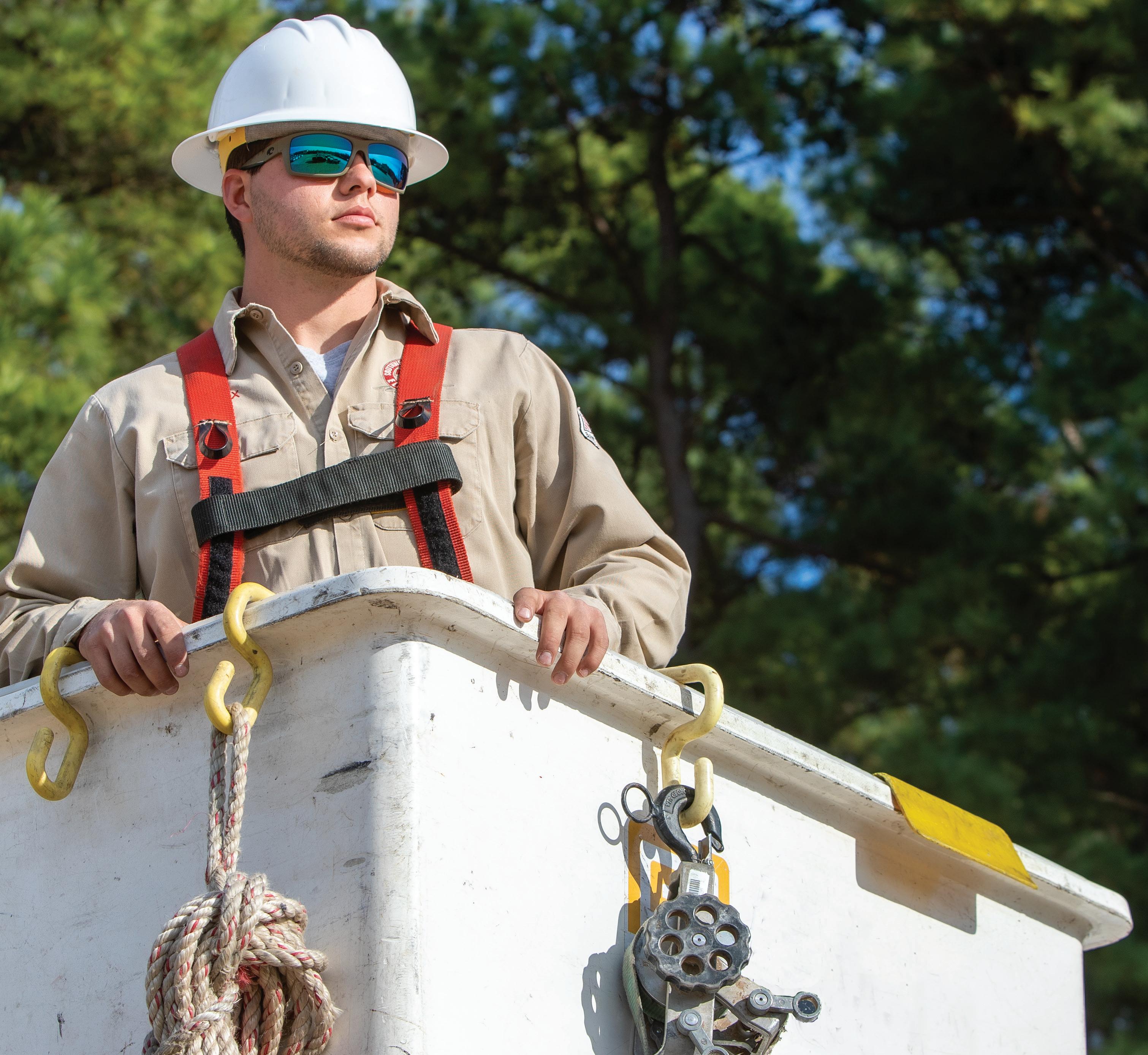


|
22 | Innovating the way Maverick Transportation has been a recognized industry leader in safety and technology, which served it well during the pandemic.
44 | Legacy Awards
Junior Achievement recognizes its 2021 award winners in May, shining a spotlight on those who show a commitment to education.
48 | Pathfinder
Financier Rush Harding claims simply to have followed the path to success set before him by mentor Sheffield Nelson.
53 | Generations
AMP once again recognizes generational businesses in Arkansas, including Power Technology Inc., a laser manufacturer.



100 | Van Muss?
Just how long might Razorback basketball coach Eric Musselman stay in Fayetteville? Evin Demirel ponders whether he’s here for the long haul.
Linda and Rush Harding don the cover of this month’s AMP. Photographed by Jamison Mosley at Cache Restaurant, the Hardings are included in our version of Arkansas’ Dynamic Duos.
Page 30

political,
PRESIDENT & PUBLISHER
Heather Baker | hbaker@armoneyandpolitics.com
EDITOR
Mark Carter | mcarter@armoneyandpolitics.com
ASSOCIATE EDITOR
Katie Zakrzewski | katie@armoneyandpolitics.com
ART DIRECTOR
Jamison Mosley | jmosley@armoneyandpolitics.com
PRODUCTION MANAGER
Rebecca Robertson | rrobertson@armoneyandpolitics.com
DIGITAL MEDIA DIRECTOR
Kellie McAnulty | kmcanulty@armoneyandpolitics.com
GRAPHIC DESIGNER
Lora Puls | lpuls@armoneyandpolitics.com
COPY EDITOR
Lisa Fischer | lfischer@armoneyandpolitics.com
CONTRIBUTING EDITOR
Dustin Jayroe | djayroe@armoneyandpolitics.com
ONLINE EDITOR
Tyler Hale | thale@armoneyandpolitics.com
SENIOR ACCOUNT EXECUTIVE
Greg Churan | gchuran@armoneyandpolitics.com
ACCOUNT EXECUTIVES
Tonya Higginbotham | thigginbotham@armoneyandpolitics.com

Mary Funderburg | mary@armoneyandpolitics.com
Tonya Mead | tmead@armoneyandpolitics.com
Kyle May | kyle@armoneyandpolitics.com
Shasta Ballard | sballard@armoneyandpolitics.com
ADVERTISING COORDINATOR

Jacob Carpenter | ads@armoneyandpolitics.com
CIRCULATION

Ginger Roell | groell@armoneyandpolitics.com
ADMINISTRATION
Casandra Moore | admin@armoneyandpolitics.com
CEO | Vicki Vowell
TO ADVERTISE call 501-244-9700
email hbaker@armoneyandpolitics.com
TO SUBSCRIBE | 501-244-9700
ADVISORY COMMITTEE
Joyce Elliott, Arkansas State Senator; Gretchen Hall, CEO, Little Rock Convention & Visitors Bureau; Stacy Hurst, Secretary, Arkansas
Department of Parks, Heritage & Tourism; Heather Larkin, CEO, Arkansas Community Foundation; Elizabeth Pulley, CEO, Children’s Advocacy Centers; Gina Radke, CEO, Galley Support Innovations; Steve Straessle, Principal, Little Rock Catholic High School; Kathy Webb, Representative, Little Rock City Board
EDITORIAL INTERN
Kayla McCall
CONTRIBUTORS
Madeline Burke, Angela Forsyth, Becky Gillette, Rob Guthrie, Kenneth Heard, Dwain Hebda, Carl Kozlowski
AMP magazine is published monthly, Volume III, Issue 12 AMP magazine (ISSN 2162-7754) is published monthly by AY Media Group, 910 W. Second St., Suite 200, Little Rock, AR 72201. Periodicals postage paid at Little Rock, AR, and additional mailing offices. Postmaster: Send address changes to AMP, 910 W. Second St., Suite 200, Little Rock, AR 72201. Subscription Inquiries: Subscription rate is $28 for one year (12 issues). Single issues are available upon request for $5. For subscriptions, inquiries or address changes, call 501-244-9700. The contents of AMP are copyrighted, and material contained herein may not be copied or reproduced in any manner without the written permission of the publisher. Articles in AMP should not be considered specific advice, as individual circumstances vary. Products and services advertised in the magazine are not necessarily endorsed by AMP. Please recycle this magazine.
It’s storm season in Arkansas, and that means one thing. Tornadoes. And for storm-shelter sellers, business is good.80 | A RICH HISTORY The military and economic history of Central Flying Service makes for a good yarn in Digs of the Deal.
Franklin McLarty dropped in to pose for the cover of AMP’s April issue. McLarty recently launched a special purpose acquisition group (SPAC) based in Little Rock.

LAND OF OPPORTUNITY: FRANKLIN MCLARTY BEHIND $276M LAUNCH OF ARKANSAS SPECIAL PURPOSE ACQUISITION COMPANY
“I’m honored to be on the cover of this month’s issue of Arkansas Money & Politics . A big thank you to Dwain Hebda for spending time with Beau Blair and me to discuss the launch of MDH Acquisition Corp. and our pursuit of opportunities in the Heartland. We’re proud of the team we’ve assembled and are looking forward to what’s ahead.”
Franklin McLartyLATE JULY OPENING SCHEDULED FOR COSTCO IN WEST LITTLE ROCK
“I moved here from California where Costco reigned supreme. Always loved shopping there and have dearly missed the store. Looking forward to shopping there again!”
Dee Loyd Hoffman
IT’S OFFICIAL: MUSSELMAN SIGNS DEAL TO KEEP HIM IN ARKANSAS POTENTIALLY THROUGH 2028
“It’s good to have an Athletic Director who’s on top of things.”
Richard RossMEDICAL MARIJUANA SALES IN ARKANSAS TOP $300 MILLION
“Wow selling weed is profitable. who knew.”
Anthoney WoodsREMINGTON’S LONOKE PLANT BACK IN OPERATION
“We all welcome *any* bump-up in the supply process. A FFL dealer and I were talking two months ago about the ‘supply /demand’ cycle. With 7M+ new gun owners, and last summer’s riots spiking fears, consumer demand turned like a speedboat...But... The ammo industry’s supply chain turned like an aircraft carrier. 2020= toilet paper. 2021= ammo.”
Michael Houseal1. Remington’s Lonoke Plant Back in Operation (April 12, 2021)
2. The Digs of the Deal: Mena Intermountain Municipal Airport: ‘Tails’ to Tell, Economic Engine to Drive (April 13, 2021)
3. Keet Family Bringing New Restaurant Concept to Arkansas (Dec. 3, 2020)

4. Land of Opportunity: Franklin McLarty Behind $276 Million Arkansas SPAC (April 13, 2021)
5. Costco Looking at July 2021 Opening for WLR Location (April 28, 2020)
6. Two Arkansas
7.
Arvest Bank has named Brooks Davis new community bank president for its Conway and Morrilton markets.

9.
8.
Great minds.... Arkansas Money & Politics all the way. This is our amazing ad coordinator, Jacob Carpenter at AY Media Group with our leader, Heather Baker.

HadStar Wars not landed on planet Earth in 1977 and redefined the movies, the highestgrossing film in the United States that year would’ve been one that included an Arkansas setting. Yep, Smokey and the Bandit
Burt Reynolds, the Florida native who was quite partial to the Natural State, was the world’s top box office star at the time, and he played the Bandit, as no one else could’ve. No scenes from the film were shot here, but the plot (for you young’uns) entails a bootleg run of Coors from Texarkana to Atlanta. (Back then, as hard as it must be for some to fathom today, Coors “banquet beer” wasn’t available east of Oklahoma. Which, of course, made it seem much more exotic than it actually was.)
A good chunk of the action is set in Arkansas, though (and filmed in Georgia), and one Arkansas State Police car gets the honor of playing keystone cop to the Bandit and his iconic, black Trans Am.

Smokey and the Bandit, turns out, originally was intended as a low-budget “B” movie until Reynolds got a hold of the script, and plans changed. Sally Field and the incomparable Jackie Gleason — the Smokey of the title, and if you’re not sure just what it refers to, well, just Google it — were added to the cast, and suddenly producers had a star-studded, screwball
comedy on their hands.
The movie was a hit and became a true cultural phenomenon. Its theme song, “Eastbound and Down” — preKenny Powers, for you young’uns — from Reynolds’ sidekick and co-star Jerry Reed became a hit as well.
So, why Smokey and the Bandit? Well, this month’s issue of AMP talks trucking. We visit with the Arkansas Trucking Association, Maverick Transportation, ArcBest, C.C. Jones Trucking and more about the challenges facing the industry right now and how the pandemic may have helped rehabilitate the image of the truck driver.
Also inside, we take to the air one last time to visit Central Flying Service for Digs of the Deal. And Executive Extracurriculars hits the links, where golf is, well, let’s just
say it’s eastbound and down. Great stuff, as always, from Katie Z and the Heb. And veteran scribe Ken Heard reels off a projectionist’s tale in The Last Word.
Word-of-the-month honors for May go, unwittingly, to columnist and author Jonah Goldberg: recalcitrant. Google reminded me of its precise meaning (I was basically there), which is defined in adjective form as “having an obstinately uncooperative attitude toward authority or discipline,” and in noun-form, as “a person with an obstinately uncooperative attitude.”
So, have we entered into the age of recalcitrance? Recalcitrant, turns out, is from the Latin calcitrare, meaning “to kick,” as in, kicking back. Yep, I think maybe we have.
And speaking of movies, despite the absolute price gouging, the experience of movie theater popcorn and previews just can’t be replicated at home. Just something about it. But I’m afraid we’ve seen the last generation that relies on movie theaters as a primary source for film viewing. Changing times and all…
As always, thank you for reading. Let me know how we’re doing, good or bad, at MCarter@ARMoneyandPolitics.com.
By Heather BakerEach issue of Arkansas Money & Politics is near and dear to my heart — you wouldn’t expect me to have a favorite child, would you? — but this issue has special meaning for me.
Not only do we introduce our version of Dynamic Duos, recognizing some of the state’s most powerful business couples/partners, and recognize Arkansas’ generational businesses, but we shine a light on Junior Achievement and the important work it does.
This month, JA Legacy Awards luncheon will recognize those Arkansas business leaders (and one business) who have committed to helping JA fulfill its mission of promoting financial literacy among Arkansas students.

This year’s Legacy Award winners are: Anne Marie Doramus of Arkansas Bolt and Arkansas Game & Fish commissioner; Rush Harding of Crews & Associates and Cache Restaurant; and Little
Rock Mayor Frank Scott Jr. The 2021 Educator Award winner is Dr. Gary Arnold of Little Rock Christian Academy. And Centennial Bank is the recipient of the Nelson Summit Award, recognizing a business that supports education.
Making sure our kids understand the basics of economics and are prepared — really and truly prepared — when they strike out on their own is a cause that sometimes takes a back seat. But the better our studentsturned-young adults understand the world they’ll inherit, and the finances that make it work, the better off we’ll all be.
This year’s luncheon will be held in person on May 27 at Heifer International and also live streamed. Visit JuniorAchievement.org/ web/JA-Arkansas for more information.
Comments? Questions? Story ideas? Hit me up at HBaker@ ARMoneyandPolitics.com.
 BY ROB GUTHRIE
BY ROB GUTHRIE
Energy and alternative sources are hot topics of conversation nationally, and there’s no shortage of related opinion, research and trends across a range of industries. However, I’ve seen a consistent and increasing shift toward energy strategies that transfer significant operational risk to the developer, maximize tax benefits, monetize assets and preserve or enhance balance sheet and credit-rating metrics.
To a large extent, the national solar industry has been a trendsetter in this movement, with no-cost delivery methods like the power-purchase agreement or solar-services agreement. What we’re seeing now is the application of these same concepts, with a few key enhancements, to thermal energy assets, waste-to-energy concepts and other related areas.
The real innovation for me hinges on Energy-as-a-Service (EaaS) solutions. To begin to understand their value, I think you have to start by distinguishing yesterday’s “product economy” from today’s “subscription economy.” In the product economy, consumers would drive to retail locations (think Tower Records) and make a one-time, upfront payment in exchange for ownership of a static product. After the transaction, the consumer owned the product outright and incurred the burdens of ownership: control of the product, an obligation to maintain the product, risk of loss through damage and risk of loss/depreciation through functional obsolescence.
Subscription-economy flagships like Netflix and Spotify gambled that consumers would much prefer to shed the burdens of ownership and keep the benefits (i.e., the value from the product itself) under a monthly subscription model. To say they were right is an understatement. The number of subscriptions in the United States has increased exponentially in the past 20 years, while
companies like Tower Records have long since gone bankrupt.
The revolution we’re seeing in today’s energy industry borrows from these very same root concepts. The product economy delivery methods require the building owner to borrow a significant amount of money to fund energy-efficiency improvements to a facility. The building owner then receives a static product with a how-to manual, a 12-month warranty and an obligation to operate, maintain, renew and replace the assets over its life cycle. Because most building owners recognize that plant maintenance is a noncore function, it’s not hard to imagine why so many see their energy cost savings erode under this model.
EaaS brings to the energy sector what Netflix brought to home entertainment. With an EaaS solution, the building owner sheds the burdens of acquiring, renewing, operating and owning the asset to the counterparty and pays a monthly subscription fee in exchange for 24/7/365 availability and service. No big upfront payments, no debt on the balance sheet and no operational headaches.
Health care and higher education have seen the benefits of this model. And even local institutions like the University of Arkansas for Medical Sciences (UAMS) in Little Rock have capitalized on these agreements, including its recent energy-savings performance contract with my team at Bernhard. Once completed, UAMS’ energy-efficiency ranking will be in the top 1 percent of all academic medical centers in the United States, in addition to annual savings estimated at $4.8 million. This is a very involved project that incorporates power generation, airside and waterside mechanical improvements, controls upgrades, lighting improvements and other services designed to generate measurable and verifiable savings on an annual basis.
Beyond UAMS, I’ve been engaged in approximately $500 million in EaaS arrangements for health care and higher education clients in just the past year. These transactions are spread across four different U.S. states and include many hallmark EaaS benefits, such as asset monetization, risk transfer, energy optimization, infrastructure renewal and credit-rating uplift.
While new to many nationally, EaaS has been a commitment from Bernhard for some time. With more than $700 million in closed EaaS transactions under our belt, we are a confident market leader. I still see misconceptions that are hangovers from the old delivery methods. EaaS has put an end to the “it-takesmoney-to-save-money” philosophy that many building owners still (unfortunately) subscribe to.
Under the EaaS framework, improvements are typically funded by the developer, relieving the building owner from straining cash reserves or debt capacity. No doubt that many hangovers remain, but I’m motivated by valuable innovations like EaaS and the subscription economy. It’s that simple: It just works.
Rob Guthrie is the executive vice president for Bernhard’s Development Division, where he is responsible for leading the Bernhard team in the successful development of turnkey Energy-as-a-Service projects for clients in health care, higher education and commercial sectors. Learn more at Bernhard.com.
For Dr. Tansel Karabacak, 2017 Arkansas Research Alliance Fellow and member of the ARA Academy, physics began as an “intellectual adventure.” When his doctoral advisor inspired him to connect fundamental science to applications, he realized he had found his true calling.

From his lab at the University of Arkansas at Little Rock, Karabacak focuses his research on the synthesis of nanomaterials and their applications in energy, the environment and human health. His team’s latest innovations have sparked collaborations with major companies around the globe.
AMP: Your work is rich with commercial opportunities. What challenges must researchers overcome to bring research to market?
Dr. Karabacak: In my opinion, one fundamental challenge is the scarcity of communication between industry and academia. As a scientist, I would like to listen to people from industry and learn more about the challenges they are facing. Similarly, industry does not seem to be aware of great technological opportunities developed in universities. In other words, academia and companies need to talk more.
Another challenge is navigating the bumpy road of transitioning exciting technology to the commercial market. University researchers are not always equipped with proper expertise in commercialization or simply do not have enough time among their other responsibilities in the university such as teaching and mentoring students. It would help a lot if we had more startup companies in Arkansas, especially in Central Arkansas, as local startups tend to engage more with academic researchers.
It would also be valuable to have a streamlined process of interfacing between academia and entrepreneurs with a clear focus on communicating with university researchers, understanding the technology, identifying opportunities to reduce technical risk and leading the way towards commercialization.
AMP: With an assist from an ARA Impact Grant, you and your team have developed a process that has caught the interest of some major industrial powerhouses. What can you share?
Dr. Karabacak: We developed a new surfaceengineering method, which we named “hot water treatment,” to introduce a nanostructured layer on a metallic material by simply immersing the metal in hot water or exposing it to steam. The method is extremely simple, does not require any chemical additives and is therefore environmentally friendly. This novel approach is applicable to most of the elemental metals and their alloys, is low-cost and is scalable to industrial processing.
In our ARA Impact Grant project, we investigated the antimicrobial applications of nanostructured surfaces developed by hot water treatment. We focused our studies on aluminum, copper and zinc due to their wide use in applications that involve exposure to bacteria. For example, we demonstrated that aluminum foil becomes highly antibacterial after a hot water treatment less than a minute at 75oC (167oF), killing more than 95 percent of the bacteria. This has received the attention of an aluminum foil company and led to the start of a collaborative project, which is currently in its early stages.
AMP: Why are companies interested in hot water treatment?
Dr. Karabacak: There are several potential applications of hot water treatment that we’re currently investigating, and we’re already in communication with several companies. A few of these applications include antimicrobial surfaces (e.g. for medical implants, food packaging and HVAC systems), water treatment and supercapacitors. However, there are many other potential applications that we
would like to investigate such as medical devices, hospital furniture, batteries, solar cells and fuel cells.
AMP: How do you and your team move forward with commercialization?
Dr. Karabacak: We have a few pending patents that are expected to receive the attention of companies for licensing opportunities. We also have submitted a few grant proposals for product development toward commercialization with a start-up company in Arkansas. We plan to continue these efforts in transferring our technology to commercial applications.
AMP: This is terrific insight to how research becomes a viable commercial solution. Parting thoughts?
Dr. Karabacak: I would like everyone to know that we develop novel materials that are relevant to Arkansas’ economy and that research is an integral part of education at UA Little Rock. We care about applications of our research as much as we care about the new fundamental knowledge it generates. We are looking forward to learning more about the needs of our local industry and aligning our research accordingly. Let’s start a dialogue and build something meaningful together.
The Arkansas Research Alliance Academy of Scholars and Fellows is a community of strategic research leaders who strive to maximize the value of discovery and progress to advance the knowledge-based economy of the state. Learn more at ARAlliance.org.
Arkansas has exceeded its netrevenue forecast by more than $716 million.
The latest General Revenue Report, released May 4, shows that Arkansas has a year-to-date net available general revenue of $5.4495 billion. Compared to the same time in 2020, Arkansas’ current revenue is 13.6 percent higher, representing a $651.7 million revenue increase.
With two months left in the current fiscal year, Arkansas surpassed its revenue forecast by 15.1 percent or $716.8 million.
Gross general revenues also increased substantially this year, rising $640.7 million, or 11.1 percent, compared to the previous fiscal year. In the year-to-date, Arkansas has pulled in $6.430 billion, which is above the forecast by 12.4 percent or $711.1 million.
Individual income tax collections were higher than 2020 tax collections by 10 percent or $287.8 million. In the current fiscal year, Arkansans has collected approximately $3.168 billion in individual income taxes, which is $291.7 million and 10.1 percent above forecast.
With the increase in income tax collections, individual tax refunds were down to $378 million, which is a decrease of $49.6 million or 11.6 percent from last year. This was $23.3 million below the forecast. The Arkansas Department of Finance and Administration attributed this to the filing extension being moved to May 17.
Corporate income taxes were up by $92.5 million in the yearto-date, rising to $496.3 million. This was above forecast by 37.6 percent, or $135.6 million. Corporate income tax refunds also increased by $14.6 million, coming in at $61.7 million so far this fiscal year.
In April 2021, the state’s net-available general revenues totaled $77.9 million, which was $242.4 million above the revenues in April 2020. It was $166.9 million, or 27.2 percent, above the state’s forecast.

Gross general revenues for April 2021 were $947.8 million, an increase of 37.8 percent or $260 million from April 2020.
Medical marijuana sales have topped $300 million in Arkansas since the first dispensaries opened in the state in 2019.
According to the latest report from the Arkansas Medical Marijuana Commission, there have been 45,286 pounds of medical marijuana sold in Arkansas since that time. In total, medical marijuana sales have reached $303.5 million in Arkansas as of May 2.
Since the last medical marijuana sales report, released on April 13, there have been approximately $18.5 million in sales. The April 13 report showed $285 million in sales.
In 2021, there has been approximately $85 million in medical marijuana sales. In January 2020, the Medical Marijuana Commission reported that the state had recorded $218.1 million in sales at that point in time (Jan. 13, 2021).

Currently, there are 38 licensed dispensaries with 32 active and six working toward opening. Throughout Arkansas, there are 76,533 active patient cards, according to the Arkansas Department of Health.
Based on the MMC report, Arkansans are spending approximately $885,000 per day on medical marijuana.
Windsor Door will be adding a third production line and second shift at its Little Rock manufacturing center, resulting in 42 new full-time jobs.
The Little Rock-based residential garage- and overhead-door manufacturer is investing in the new production line due to increased demand spurred by construction growth in the United States. With the new jobs, Windsor Door will grow to 150 employees.

“Windsor Door is proud to announce the expansion of its current operation,” Windsor Door Executive Vice President Hans Wright said in a statement. “We are implementing an additional line and adding shifts to our tenured workforce. Windsor Door prides itself on being a place where Arkansans can build a career. Many of our team members
exceed 30 plus years of dedication and employment.
“Our hope with the expanded capacity is to offer career-building opportunities for the next generation of our community. We currently have job openings that range from skilled labor to entry-level positions. We encourage all to apply and look forward to adding to the Windsor family.”
According to a Little Rock Regional Chamber release, Windsor Door is set to begin hiring for the 42 new positions immediately. These roles will be posted to Indeed.com.
“The City of Little Rock is excited about the opportunity for more jobs during this crucial time of rebuilding,” Mayor Frank Scott Jr. said. “I’m grateful to Windsor Door for making a home here and seeing value in expanding its opera-
tions in the state’s capital city.”
The company, which has a 74-year history in Arkansas, also has distribution centers in Ontario, Calif., and in the Texas cities of El Paso, Houston, Arlington and Richardson.

Tyson Foods is expanding its poultry operations in Arkansas, with plans to invest $48 million to accelerate the growth of its Pine Bluff poultry plant.
Established in 1991, the Pine Bluff facility produces fully cooked chicken products, intended for both food service and retail. As part of this expansion, Tyson announced that it would be increasing the capacity of the processing lines, which produce chicken tenders and chicken strips, as well as boneless and bone-in wings and air-fried products. Tyson will automate the product packing lines, in addition to the food manufacturing expansion.
Currently, the Pine Bluff plant employs approximately 1,100 individuals. The company estimates that the expansion will create 70 new jobs. In the 2020 fiscal year, Tyson reported paying roughly $47 million in wages.
“The demand for convenient, high-quality chicken products continues to grow, and we’re investing in projects that meet the needs of our customers and consumers,” Donnie
King, chief operating officer and group president of Tyson Foods’ poultry division, said in a statement. “We’d like to thank the Arkansas Economic Development Commission and the Economic Development Alliance for Jefferson County for their assistance and support of this project.”
The expansion project is slated to be complete by late 2021.
“Tyson Foods is a homegrown company that has forever altered the economic landscape in Arkansas,” Secretary of Commerce and Arkansas Economic Development Commission director Mike Preston said. “Poultry production is responsible for about 25 percent of the agriculture jobs in Arkansas, making the state one of the top five broiler producer states in the country. This expansion is a direct reflection of Tyson’s commitment to the Pine Bluff community and the confidence they have in our workforce.”
According to a Tyson release, the company had a statewide economic impact of $2.1 billion in fiscal year 2020.

One of the biggest issues facing trucking carriers today — and one that can’t help but also impact the cost of the goods being transported — is rapidly increasing costs for insurance.

“There are situations in the industry where premiums have almost doubled in the past three years, and we don’t see that trend changing in the near future,” said Rochelle Bartholomew, president and CEO of CalArk International in Little Rock. “Rising insurance costs are a very large concern for many motor carriers. The average claims’ cost has tripled, especially when an injury is involved. It is not uncommon that carriers pay out north of $5 million if they have a fatality.”
What she describes as “nuclear verdicts” have been more common in the past five years. Bartholomew said that even when carriers are trying to do the right thing and have strict safety programs and good equipment, they still have a slim chance of winning cases because of the industry’s “unfortunate” nega-
tive reputation due to some circumstances that are outside of its control.
When insurance costs increase, the best thing carriers can do to limit costs is to operate as safely as possible, said ArcBest Vice President of Investor Relations David Humphrey. As the only seventime winner of the American Trucking Associations President’s Trophy for safety — the highest safety honor in the industry— ArcBest is proud of its safety record and will continue to invest heavily in safety initiatives, he said.
“Our ABF Freight tractors are equipped with forward-facing cameras, lane-departure technology and collision-avoidance systems, plus our drivers are consistently trained and coached on how to operate equipment safely,” Humphrey said. “On our asset-light side, we maintain a strict vetting protocol to ensure we’re utilizing safe carrier partners.”
Driver shortages have been an issue for years. Humphrey said finding the right employees and filling available career opportunities is challenging right now for all carriers, especially as capacity demands increase.
“In the first quarter of 2021, we were able to add to our asset-based workforce on a net basis, and it helps with retention that we pay the best wages and benefits in the industry and that many of those drivers are home every night,” Humphrey said. “We also have several veteran hiring initiatives in place to help bolster our driver workforce. By utilizing the skills and experience of military members, we’re filling an employment need while also offering soldiers a stable, prosperous career once their military service is complete.”
CalArk’s Bartholomew said while the driver shortage has been a problem for many years, it is especially critical now with the rise in demand, the current condition of the economy and the unemployment offerings that are taking place. It has been estimated that in the past year, about 250,000 U.S. drivers either left the industry due to the pandemic or didn’t enter the industry because of all of the restrictions.
“That is a huge impact on carriers, and it will take years to overcome the loss we have endured,” Bartholomew said. “The Drug and Alcohol Clearinghouse was created with the best of intentions for carriers, and we are very much grateful for the clearinghouse, but it is also a contributor to the amounts of drivers exiting the industry, for good reason. Over 60,000 drivers were added to the database
that tested positive for drugs or alcohol in 2020, and only a small percentage have been found to go through a substance-abuse program to get back into the industry.”
Another negative factor is the age restriction. Bartholomew said it is difficult to invite young talent to the industry when they have to be 21 years of age to act in interstate commerce. That means students graduating from high school have to wait three years before they can work for an interstate motor carrier.

The average age of a driver in the industry is in the mid-50s, which is concerning for what the next five to 10 years will hold. “Many drivers are retiring now, and some can’t qualify medically, which will get harder as they age,” she said. “It has been stated that the industry will have to onboard over 1 million drivers in the next 10 years to keep up with demand.”
Autonomous vehicles are becoming more common and getting support from the largest carriers in the industry. Bartholomew said this is going to be a topic for some time to prepare for the lack of drivers in the industry. She sees potential help through working with the Drive Safe Act that the American Trucking Association created and pilot programs for 18-year-olds with restrictions. And she said they are continuing to diversify offerings to better fit the wants and expectations for the workforce.

It has been estimated that in the past year, about 250,000 U.S. drivers either left the industry due to the pandemic or didn’t enter the industry because of all of the restrictions.Rochelle Bartholomew David Humphrey







hester Charles “Shorty” Jones began his trucking business with a 1954 AutoCar diesel truck, a strong work ethic and family values while he hauled poultry from Arkansas to the West Coast and oranges back home.
Now, more than 60 years later, C.C. Jones Trucking Inc. of North Little Rock has 20 company drivers and an additional 15 independent haulers and is considered one of the pioneers in the state’s trucking industry. The work ethic and family ties remain. Jones’ daughter, Vicki Jones Stephens, and her son, Gabe Stephens, run the business. The company, which has an annual revenue of $7.3 million according to Dun and Bradstreet, still hauls to California and back and logs about 5 million miles a year.
“It’s extremely personal,” Vicki Stephens said of her own work ethic. “This is about my father.”
Although Vicki, 73, admits she cannot drive an 18-wheeler, she’s been around trucks all her life. By the time she was 5 years old, she had been to most U.S. states while riding with her father on cross-country deliveries.
C.C. Jones was 14 when he drove his first truck, transporting goods from his family’s farm to local markets in Little Rock. He served in the U.S. Navy during World War II, returned home in 1945, got married three years later and had four daughters. In 1955, he became the first driver to haul California Sunkist oranges across the Mississippi River into Memphis, and after an accident that left him with a broken back, he continued to haul produce while in a body cast. Doctors told him he would never walk again, let alone drive a truck.
That was unacceptable for Jones; he had a wife and children, and he had to continue making money by hauling his poultry and citrus goods. People teased
“It’s extremely personal,” Vicki Stephens said of her own work ethic. “This is about my father.”
Jones, who was considered a pioneer in Arkansas trucking, that his initials C.C. stood for “Chicken Charlie” or “Cold Cash.”
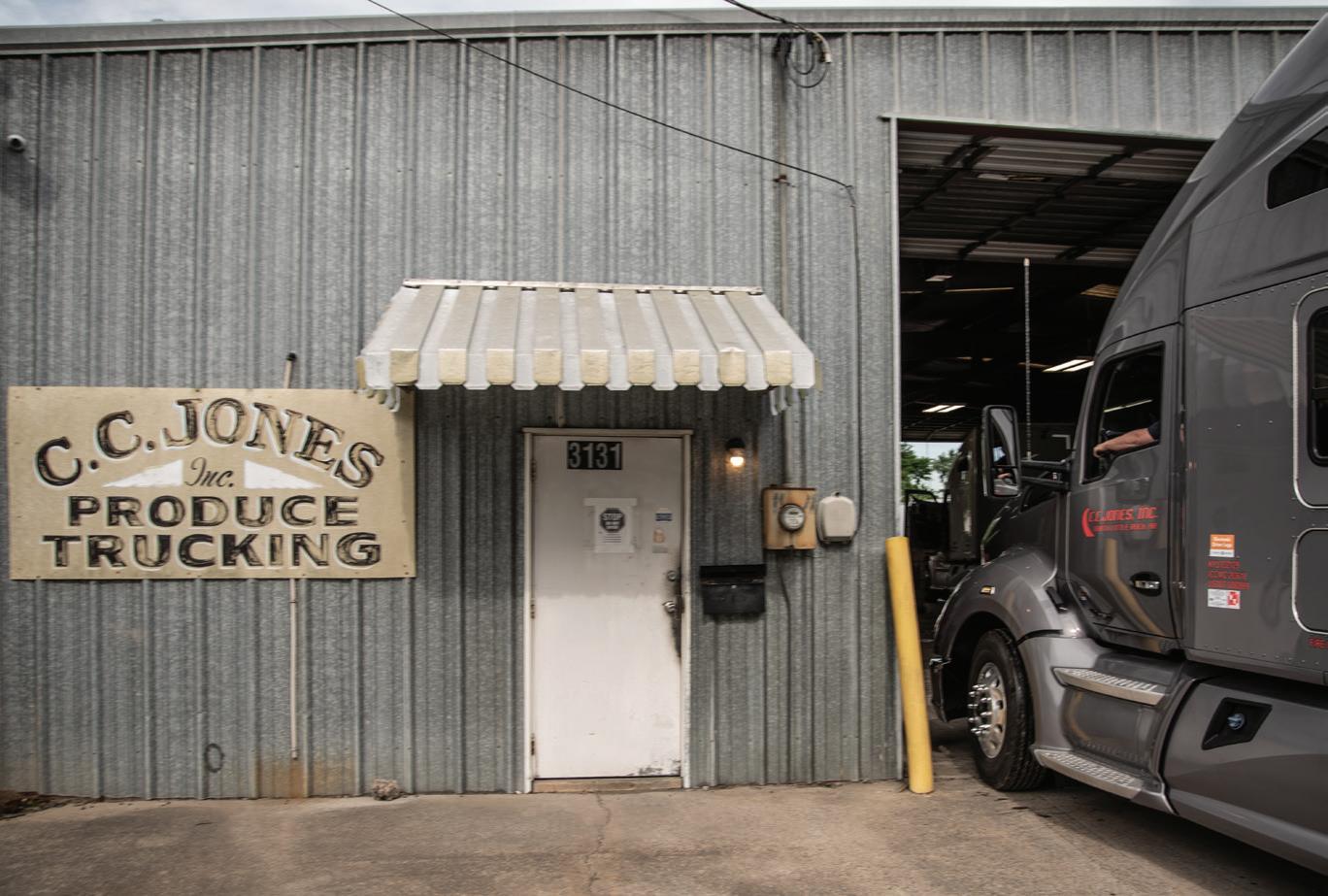
In 1960, he wanted to be with his family so Jones and W. T. Kidd formed his company, C.C. Jones Trucking Inc., hiring drivers to replicate the long hauls he made to the West Coast and back. His daughter, Vicki, went to work for the company when she was 18. She had a choice then, she said, of either going to college or getting married and going to work. She picked love, marrying her childhood sweetheart, and applied for a job as an operator for the telephone company.
Vicki was given the job, but at the same time, her father needed a bookkeeper for his trucking business. Vicki graduated high school in May 1966 and began working for her dad at $40 a week.
“I was the son he never had,” she said. “My dad did a good job of laying the groundwork for this business. He was truly committed to the industry.”
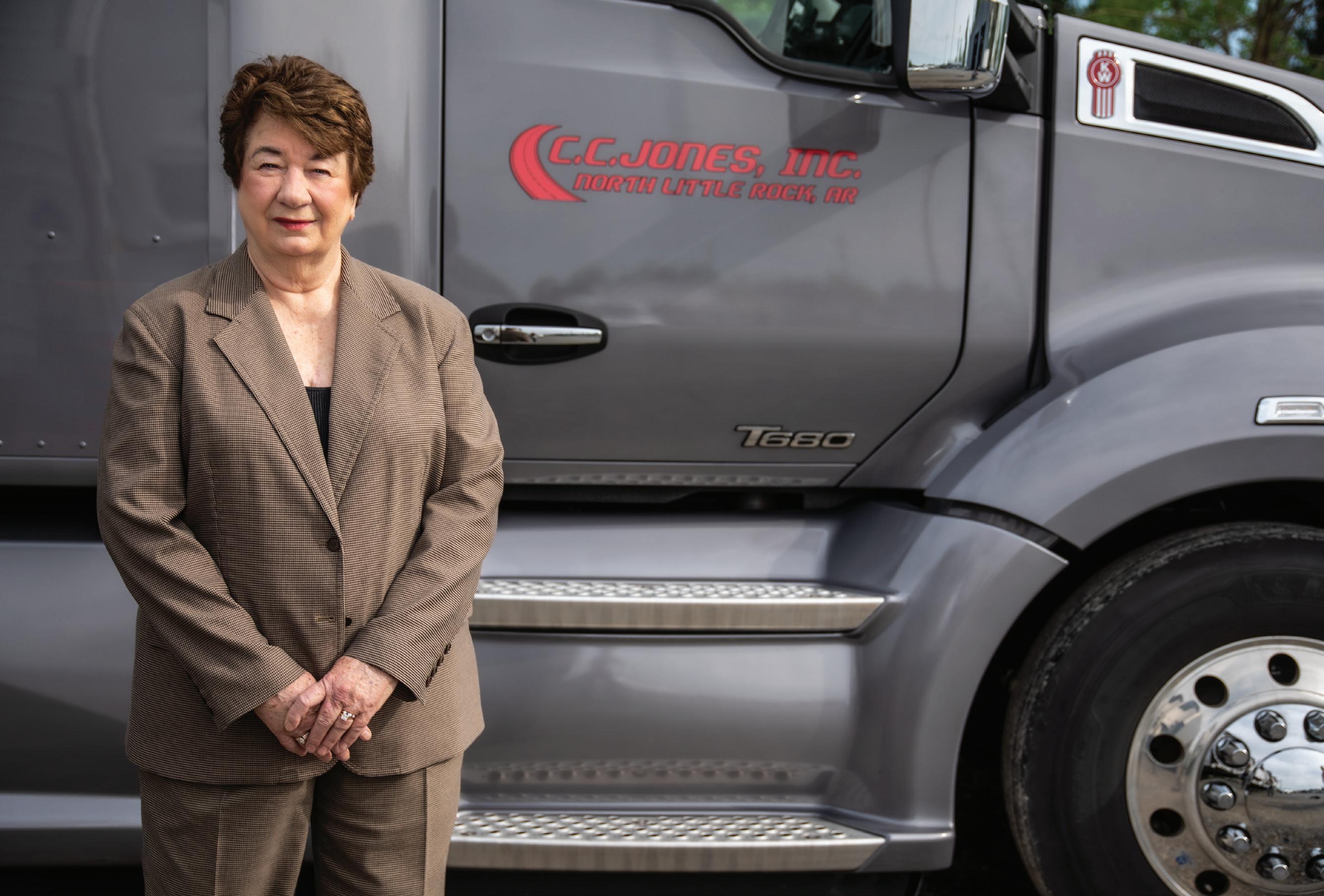 Vicki Stephens made sure that C.C. Jones Trucking remained a family operation.
Vicki Stephens made sure that C.C. Jones Trucking remained a family operation.
Gabe Stephens said the company has survived by hiring the right people.
Twenty years later, C.C. made his daughter and A.L. “Buddy” Eubanks partners with him, since the two had been with him the longest. At a time when women were not often considered for positions in the trucking industry, the choice helped establish Vicki as a viable executive. She later became the first woman to be named the chairman of the Arkansas Trucking Association and has served on several boards and committees in Central Arkansas.
Vicki and Eubanks bought the business from her father in 1990, and six years later, Vicki and her son, Gabe Stephens, bought out Eubanks. In 1997 Vicki’s father died, but he was able to see his daughter and grandson run the company before he passed away, she said.
Although Arkansas is located in the
middle of the country and has no large metropolitan areas like on either coast, trucking has thrived in the state. Interstate 40, which cuts through the heart of Arkansas, is one of the busiest highways in the country for trucks, and the intersections of Interstate 40 and Interstate 55, rife with truck stops in Crittenden County, is one of the top three most congested truck-traffic areas in the nation. The Mississippi and Arkansas rivers are home for ports that provide more opportunity for transport trucks.
Along with C.C. Jones Trucking, several trucking-industry kings have made Arkansas their homes. J.B. Hunt, based in Lowell, has annual earnings of $9.165 billion. Other Arkansas companies include Tyson Foods, CalArk and Willis Shaw Logistics LLC.

“Dad grew up during the Depression,” Vicki said. “He thought Arkansas was perfect for his family and for what he needed for his business.”
Trucking companies are “extremely fragmented” in the state, said Shannon Newton, the president of the Arkansas Trucking Association.
“We see the large companies like J.B. Hunt and the smaller, family-owned ones like C.C. Jones,” Newton said, “That’s what trucking is about. But there are certain types of operations that make handling clients personal, and that’s what Vicki does.”
Newton said hauling produce is one of the harder ventures in trucking because food has a short “shelf life.”
“It’s important to get it there on time,” she said. “It’s a difficult type of operation. They [C.C. Jones] have figured out the best way to do it.”
It wasn’t always easy when Vicki first took over the company. A grocery store that had been a major client went bankrupt. One of the new trucks was struck by lightning. It was an ominous sign, one that even her father noted. She also went through a divorce, but she continued on and focused on keeping the company successful.
C.C. Jones has survived by hiring the “right people,” Gabe said. The company
has maintained a close relationship with its employees. Both mom and son consider drivers as family.
“If you hire anybody who walks through the door, you’re in trouble,” Gabe, 48, said. “We often go with gut feelings. If a person doesn’t seem to fit, we don’t hire him.”
Drivers know exactly where and when they will be driving. They also know they won’t be “deadheading,” or returning with an empty truck, and instead they are insured loads wherever they go.
“We have an open-door policy,” he said. “Our employees are our friends.
“We’re far from perfect,” he added. “But we do what we say we’ll do. If someone says he wants to be home in time to see his grandson play baseball, we’ll get him home in time.”
The company lost some freight jobs when COVID-19 struck and businesses began closing. But the company continued to pay employees whether they delivered goods or not.
“Things got a little tough,” Vicki said. “We had some highs and lows during that time, but we kept going.”
Gabe has three daughters but has yet to determine if they will succeed his mother and him and keep the family in the business.
“They are a successful trucking company in Arkansas over three generations,” Newton said. “They’ve made a lot of impressions on people.”
It’s taken a global pandemic to help alter the image of the truck driver from the pot-bellied, amphetamine-guzzling road hog portrayed in movies to the hero who braves the virus to deliver necessary goods to stores.
Truckers first took a negative blow in the 1971 Steven Spielberg movie Duel, which featured a young Dennis Weaver spending 90 minutes driving from a smoke-belching, gas-guzzling tanker truck that terrorized him on a two-lane California highway. The truck driver was never clearly shown in the film, giving the truck a more evil, ominous role.
That concept was furthered in Maximum Overdrive, the 1986 dud written and directed by Stephen King. In that film, trucks came alive and trapped travelers in a truck stop. Actor Emilio Estevez resorted to using a rocket launcher to blast a Western Star 4800 diesel truck adorned with a goblin mask on its grill.
When truck drivers were shown in movies, they usually were criminals. Burt Reynolds and Jerry Reed were hired to haul beer illegally across state lines in the 1977 movie Smokey and the Bandit, and Reed returned to the road a year later in High Ballin’
And don’t forget films like White Line Fever in 1975, Breaker, Breaker in 1977, Convoy in 1978 and Coast to Coast in 1980.
Movies aren’t the only thing slamming drivers. The FBI once concluded that the trucking profession was convenient for serial killers after investigating several cases that involved truck drivers across the country. A 2013 Reuters survey revealed 12.5 percent of U.S. truck drivers tested positive for alcohol use, and 20 percent admitted to using marijuana.
“It seemed like every time you’d turn on the television, there’d be a lawyer advertising about truck wrecks,” said Gabe Stephens, co-owner of C.C. Jones Trucking in North Little Rock. Firms like Morgan and Morgan, a national legal chain with offices in all 50 states, peppered late-night television programs with such advertising.
“But, since the pandemic, you don’t see as much,” Stephens added.
“I think people realized how essential the trucking industry is,” said Shannon Newton, president of the Arkansas Trucking Association. “It connects where what you need is to where you are.
“People all stayed in place during the pandemic quarantines. But they still needed the food and water. They saw how the truck drivers brought it to them, despite not knowing where they could stay on the road due to the virus.”
Despite the improved image of truckers, there is a national shortage of drivers, the American Trucking Association reported. There are 3.5 million truck drivers in the United States, the association noted in a news release issued earlier this year. However, there are about 63,000 vacancies in the trucking job market this year, and the industry is predicted to need 174,000 new drivers by 2026.
Darla Nation, an advanced instructor of certified driver training at Arkansas State University-Newport, said she is aware of the negative image of truck drivers.
“[We] strive to change the perceptions …” she said. “Truck drivers have always been essential, but the pandemic has truly brought to light the dedication and skill it takes to keep our trucks on the road.”
Stephens said his drivers continued to haul produce during the pandemic, and that helped better the truck driver’s image in the public eye.
“I think it was eye-opening to the public,” he said. “If you need something, we bring it.”




to the nearly 90,000 truck drivers, technicians and other transportation professionals in Arkansas who have worked tirelessly to deliver food, medicine and supplies to our communities in the midst of the COVID-19 pandemic.



Businesses, hospitals, families and neighborhoods have relied on the passion and determination of essential workers like truck drivers to

The trucking industry has rarely been so valued as during the pandemic, when grocery stores and other retailers were struggling to keep the shelves stocked with toilet paper, paper towels, sanitizer, meat, appliances and laptop computers. In the past, most people probably gave little thought to the importance of trucking in the supply chains.
And while factories were struggling to continue or, in some cases, ramp up production while preventing the spread of COVID-19, trucking companies had to quickly pivot to protect their drivers while meeting the challenge of keeping Americans supplied with vital goods.
One company that was well-poised to handle the pandemic curveballs was North Little Rock-based Maverick Transportation, which has about 2,000 em-

ployees and operates 1,600 trucks coastto-coast in the United States, Canada and Mexico.
Shannon Newton, president of the Arkansas Trucking Association, told Arkansas Money & Politics that embracing technology isn’t new for Maverick.

“Before, during and after the pandemic, they have a reputation for being early adopters and leaders in the industry,” she said. “I think a lot of people might be surprised and interested to learn about all the technology and gamification in their equipment and driver management systems.”
John Coppens, vice president of operations for Maverick, said there isn’t anything the company does in operations that doesn’t involve safety and technology.
“Our dispatch processes use multiple
programs, including an Estimated Time of Arrival Projection (ETAP) program that informs our logistics managers of a driver’s current hours and if those hours will allow for on-time delivery that meets our hours of service/safety criteria,” Coppens said. “The best thing technology does for operations is it gives us the opportunity to share information and get information quickly, allowing us to make decisions that are good for drivers and for the company. Our in-cab technology is always evolving and improving. It must be constantly evaluated to make sure we are communicating without micromanaging and in a way that improves the driving job.”
Coppens sees safety technology in the future becoming smarter and easier to use. Any improvements require a lot of hard work to make sure the technology isn’t interfering with the driving job, making the job less attractive.
“There can be so many sounds, lights and devices in the cab of a truck that it can feel like every move is being micromanaged,” he said. “It can become overwhelming. I think the technology will become less invasive and more intuitive. The really good technologies become those things that make you say, ‘Oh, I wouldn’t want to do without that.’”
Coppens said technology and safety efforts help with both recruitment and retention.
“Retention is extremely important to combating the driver shortage,” he said. “Drivers are your best advocates, and if they feel good about your safety culture and how you use technology, they will stay and share with prospective drivers what to look for in a trucking company.”
Administrative staff has worked from home for the most part during the pandemic. Being out of their offices and terminals in large part has made it more difficult to have that personal bond or connection they were used to.
“Whether it is meeting with new drivers, new non-driving hires or those people you have known for years, it takes a toll,” Coppens said. “Video conferencing technology is great, but it doesn’t replace personal interaction. It will be a major plus


to have the celebrations, events and driver advisory meetings we all took for granted back again. I would also add that we are very fortunate to have great drivers and people in our maintenance and drivertraining teams that haven’t had the ability to work from home. Where would we be without them?”
Maverick’s training team has not had the luxury of working from home, as it was important to keep its school open.
Dean Newell, vice president of safety and driver training said “They have done an outstanding job with our protocols and keeping everyone socially distanced, etc. Our maintenance teams, securement teams and on-site teams at customer locations also have been working at their respective sites in order to keep things running from their ends. Kudos to all of them as well.”
Maverick uses several different safety technologies including electronic stability control, collision mitigation systems (with automatic braking), blind spot monitoring devices and Lytx forward- and driver-facing camera technology. The company recently signed a deal to outfit its new trucks with MirrorEye Camera Monitor Systems and Lane Departure Warning, along with tire monitoring and tire inflation systems. The company also uses technology to coach its drivers.
“The videos that we receive allow us to help drivers with the habits that they have developed,” Newell said. “It allows us to share in real time instead of waiting for end-of-month reports to address things.
He expects to see trucking technology continue to advance, much like cellphones have done. New technology will become smarter and easier to use.
“I believe things will become more active with less intrusion on the drivers, much like we have all grown accustomed to our back-up cameras in our personal vehicles,” Newell said.
Some foresee driverless trucks in the future, making transportation of goods less expensive and resulting in massive job losses for truckers. Coppens doubts this will happen anytime soon.
“When I look at the roads and what would need to be done to make it happen on a large scale safely, it makes me think it isn’t that simple,” he said.
Newell is not sure where driverless truck systems will end up.
“It’s not as simple as putting a unit out there with no one behind the wheel,” he said. “The infrastructure is not there to handle this. Also, what about the motoring public? Will they accept this? Someday down the road, it may be possible, but I don’t know if it is the way of the future.
“We believe in autonomous vehicles, but not driverless vehicles. If you think about it, a lot of the technologies that we are utilizing today are part of the autonomous movement. We view them as tools to help make the driving job easier for our drivers. In our open-deck environment, we have load checks, load securements, etc., that have to be done. I don’t see a technology doing any of that at this time.”

The shift to online shopping over the course of the pandemic magnified the role of truckers in the American economy. And as the trucking industry continues to navigate a landscape impacted by COVID, it faces some unique potential roadblocks.
Shannon Newton, president of the Arkansas Trucking Association, visited with Arkansas Money & Politics about some of those challenges including a shortage of available workers.
AMP: How is the shortage of drivers, and even other industry workforce positions like diesel technicians, impacting the industry in Arkansas?
Newton: Since the pandemic began, capacity in the industry has been as tight as it has been in years with demand being driven by a sharp increase in online shopping as well as retailers and shippers working to replenish depleted inventories. With more economic stimulus, the first six months of 2021 are expected to be a lot like the last six months of last year in terms of consumer demand and online shopping.
Complicating the demand for trucking are the ongoing national driver and diesel technician shortages. According to the American Trucking Associations, in 2018, the trucking industry was short roughly 60,800 drivers, which was up nearly 20 percent from 2017. The driver shortage is further driven by the strength of the U.S. job market overall with truckers and would-betruckers having their pick of jobs and along with it, wages and benefits, forcing carriers to offer competitive wages to attract talent. The same goes for technicians; with more
trucks on the road, there’s a greater need for people who are trained to keep them in service.
AMP: Can a renewed focus on workforce development and skills training — more high school graduates opting for technical schools over the traditional college path — help in the short term?
Newton: Yes, absolutely, which is why we are proud to offer a diesel technician scholarship for graduating high school seniors. For the fourth consecutive year, the Arkansas Trucking Association plans to award scholarships of up to $7,500 to students interested in pursuing a career as a medium- and heavy-duty truck technician. ATA established the Carl Tapp Memorial Scholarship Fund in 2017 to encourage growth in the state’s technician workforce and to unlock a career path for students.
Where drivers are concerned, we’re missing an opportunity to recruit straight out of high school. Currently, there is a requirement that professional drivers be at least 21 years old to engage in interstate commerce. We’re simultaneously pursuing a pilot program currently underway with the FMCSA and also legislation (DRIVE SAFE Act) at the federal level that would allow 18-year olds to enter the industry.
AMP: How do trucking companies balance a shortage of drivers with an increased demand for their services?
Newton: Demand for freight movement is quickly outpacing the availability of trucks and drivers. As with any demand-driven market, customers are going to pay more for the short supply. Additionally, carriers are able to be more selective about which shipments they accept.
AMP: How are rising insurance costs impacting the industry in Arkansas? Are lawsuits from injury lawyers driving much of this?
Newton: Each year, the American Transportation Research Institute (ATRI) conducts a survey of the trucking industry’s top concerns. The driver shortage has long been at the top of the list but in 2020, insurance rates and insurance availability came in at No. 5.
ATRI also pointed out that these large legal verdicts, or “nuclear verdicts,” have been rising sharply since 2006. Awards of $10 million and more can be leveraged against trucking companies, even when they’re not at fault. These nuclear verdicts are driving providers out of the market, putting continuing pressure on insurance rates, and impacting all carriers bottom-lines, even forcing some to shut their doors for good.
Over the course of the 93rd Arkansas General Assembly, we supported legislation to help businesses recoup costs from claims where the employer was not at fault. The bill ultimately failed, but we were able to heighten awareness of high insurance rates, unfair judicial practices and the negative impacts on all employers.
AMP: What about the transition in Washington, D.C.? Do you anticipate any changes in regulations or policies?
Newton: The new administration has made it clear that infrastructure is a priority, and we are pleased they recognize the need to modernize and revitalize our nation’s aging transportation system. But the American Jobs Act as laid out is untenable, and there is still a lot of work to do when it comes to working out the details. We need to focus on establishing a true infrastructure-funding mechanism that is equitable and sustainable to ad-
dress the Highway Trust Fund shortfall. Additionally, the Protecting the Right to Organize (PRO) Act would upend the independent contractor model on which so much of trucking is built. It imposes the same controversial language included in California’s Assembly Bill (AB5), which would mis-classify some 350,000 small business owners as company employees, forcing many to close up shop. Even if the PRO Act ultimately fails in Congress, it’s pretty clear that policies and guidance from Department of Labor will reflect the Biden administration’s position on independent contractor versus employee.
AMP: Issue 1, passed in November by Arkansas voters, will continue to dedicate revenue from a 0.5 percent sales tax to state and local highways, roads and bridges. Just how important was its passage for Arkansas’ infrastructure, and what are the state’s most pressing needs right now?
Newton: The total revenue that will be generated for Arkansas roads as a result of Issue 1 is $290 million annually — $205 million goes to the Arkansas Department of Transportation and the remaining $85 million will be split between Arkansas cities and counties. Arkansans understood the need for this vital funding in their cities, counties and all across the state and voted in favor of Issue 1.
The trucking industry relies on all types of infrastructure throughout the state, which is one of the great things about Issue 1. Whether you are talking about farm to market roads, delivering commerce to communities in rural Arkansas or safely and efficiently passing through town, every corner of the state will benefit from this permanent funding mechanism to maintain our highway system.
3 Rivers Logistics
AAA Cooper Transportation
ArcBest
Arkansas Freight Solution
Bowerman Trucking
Brent Higgins Trucking
Brew Crew Transportation
Bruce Oakley Inc.
CalArk
Carman Inc.
CC Jones Trucking
Truckload and LTL brokerage services for both refrigerated and dry loads along with flatbed, hotshot, bulk and intermodal brokerage services.
Less-than-truckload, truck load, dedicated contract carriage, brokerage and fleet maintenance.
Intermodal and international shipping, less-than-truckoad, trade show shipping, time critical, flatbed and temperaturecontrolled services.
Freight transportation services and hauling cargo.
PAM Transportation Inc. offers dry van truckload, expedited truckload, intermodal and logistics.
Refrigerated and frozen products.
Steel transport crew offering flatbed services.
Gillett
Little Rock, Fort Smith, Jonesboro
Fort Smith
Little Rock
Searcy
Mulberry
Farmington
Road and river (barge) transportation of dry bulk commodities as well as grain storage and bulk fertilizer sales. North Little Rock
Dry van trucking services in addition to temperature-controlled warehouse and distribution.
Freight shipping and trucking.
Little Rock
Fort Smith
Heavy hauling and specialty transport; produce. North Little Rock
CCS Transportation Truckload dry van and refrigerated van services. Conway
Celo Transport
Central Hauling
Convoy Logistics
Dedicated Logistics
Diamond State Trucking
Distribution Solutions
DMT Services
EOS Inc.
FedEx Freight
Glory Transportation
JB Hunt
JD & Billy Hines Trucking
JM Bozeman Enterprises
Keen Transport
Laubach Freight
Expedited hot shot, point-to-point delivery, less-than-truckload, long distance, critical delivery and secure delivery.
Dry-box full-truckload carrier.
Full truckload, less-than-truckload, intermodal, drayage, cross-dock and warehousing.
Non-hazardous freight carrier and trucking brokerage.
Flatbed, van and conestoga trailer services.
Full truckload, less-than-truckload, dry van, temperaturecontrolled, long haul and regional shuttle.
Dry-van plate trailers for ground transportation.
Transportation services.
Less-than-truckoad services for shipments weighing between 150 lbs and 20,000 lbs.
Temperature-controlled carrier with trucking brokerage.
Intermodal, dedicated, final mile, refrigerated, full truckload, less-than-truckload, flatbed, expedited and single source services.
Customized services to move wood chips to paper mills in addition to flatbed trailers.
Dry-van truckload carrier and logistics.
Heavy-haul logistics and transportation for the construction, mining and agriculture equipment markets.
Full truckload, less-than-truckload, intermodal deliveries, hot shot, flatbed, conestoga flatbed and interplant shuttle.
Springdale
Mabelvale
Crossett
Crossett
Malvern
Harrison
Siloam Springs, Van Buren
North Little Rock
Little Rock
Fayetteville
Lowell
Prescott
Malvern
North Little Rock
Paragould
Lew Thompson & Son Trucking Regional and dedicated truckload services.
Loggins Logistics
MAGS Trucking
Marrlin Transport
Maverick Transportation Inc.
MC Express
McSheer Trucking
Morris Transportation
Old Dominion Freight Line
P.A.M. Transport Inc.
RCX Solutions
Rich Logistics
Regional and dedicated truckload services.
Huntsville
Huntsville
Dry van. Cabot
Long haul carrier for dry goods.
Flatbed, dedicated, glass and brokerage services.
Irregular route carrier with trailer leasing and dedicated service.
Truckload transportation, dedicated routes and full-service brokerage.
Long haul, regional, short haul and local services.
Less-than-truckload freight leader with air-expedited transportation, brokerage services, warehousing, supply chain consulting and container drayage.
Dry-van truckload, expedited truckload, intermodal and logistics for manufacturing, retail, and automotive industries.
Truckload, less-than-truckoad, flatbed, intermodal, temperature-control, expedited shipping and international shipping.
Scheduled truckload, expedited freight and door-to-door services.
Southern Refrigerated Transport Inc. Temperature-controlled, dry-van and hazmat services
Southland Transport Service
Specialized Services Transportation Inc. (SST)
Stallion Transportation Group
Star Transportation
Transco Lines
Tri-City Transport
Tri-National Logistics
Twin City Transportation
USA Truck
Wayne Smith Trucking
Woodfield Inc.
XPO Logistics
Hopper bottom freight, dry-van freight and temperaturecontrol freight.
Temperature-sensitive freight, dry goods and pharmaceuticals.
Van Buren
Little Rock
Jonesboro
Rose Bud
Hamburg
North Little Rock, Fort Smith, Jonesboro
Tontitown
Little Rock
Little Rock
Texarkana
Stuttgart
North Little Rock, Stuttgart
Long-haul, regional and dedicated trucking services. Beebe
Delivers petroleum products to more than 15 states.
Truckload, less-than-truckload, drayage and specialized services.
Dry and refrigerated transportation services.
Warehouse, truckload and dedicated services.
Twin City Transportation, Inc. is a third-party logistics and trucking brokerage company that offers air ride dry van trailers and flatbed services.
Dedicated, dry-van, expedited, flatbed, intermodal, lessthan-truckload, over-dimensional and temperature-controlled operations.
Ground transportation services.
Dry-van truckload services.
Less-than-truckload transportation, truck brokerage, last mile logistics, intermodal, drayage, contract logistics, ground and air expedite, global forwarding and managed transportation.
Jonesboro
Russellville, North Little Rock
Rogers
Bryant
Little Rock, Prescott
Van Buren
Morrilton
Camden
Little Rock, Fort Smith, Jonesboro




Briar wood Nursing and Rehab is a 120-bed skilled facility located in an urban setting within the heart of Little Rock, in the neighborhood of Briarwood. We are located just minutes from downtown Little Rock and are only one block off interstate 630.
We provide long-term care and short-term rehab care. All residents are monitored throughout the day with assistance in providing daily care as is needed: bathing, dressing, feeding and providing medications. Briarwood staff also work at ensuring the best care for residents through individual care plans of residents' needs, as well as daily activities, which allow for a variety of interests and abilities.
Nearly all - 98 percent - of our rehab residents return to the community as a result of positive, caring therapists. Briarwood's approach has provided healing to many people in the community.
At Briarwood Nursing and Rehabilitation Center, we are committed to ensuring that the best possible care is given to you or your loved one in an atmosphere that is calm, quiet and focused on healing. We endeavor to ensure that all aspects of your well-being — mental, physical and spiritual — are cared for in a peaceful and safe environment. Our staff strive to promote dignity, respect, and independence as much as possible, in a beautiful, soothing enviornment that was designed with our residents' comfort in mind.
Briarwood's service-rich environment is made possible by its dedicated staff, from our nursing staff and therapists, to our operations and administrative employees. At Briarwood, our residents enjoy three generations of staff and families. That is over 30 years of service to the community!

ARKANSAS IS FULL OF DYNAMIC DUOS, THOSE COUPLES AND PARTNERS WHO’VE MADE LASTING IMPACTS ON THEIR COMMUNITIES. AND THEY COME IN ALL SHADES AND SIZES, FROM COMMUNITY BUSINESS LEADERS TO THOSE ARKANSANS MAKING NOISE ON A GLOBAL STAGE.
HERE AT ARKANSAS MONEY & POLITICS, WE WANT TO RECOGNIZE THEM. WE HAVE A WHOLE SLOUGH OF DIVERSE DUOS IN MIND, NOT ALL OF WHOM WERE AVAILABLE FOR THIS INITIAL INSTALLMENT OF DYNAMIC DUOS. BUT WE’LL BE BACK LATER THIS YEAR WITH ANOTHER, AND THE SPOTLIGHT WILL FIND THEM. BECAUSE THEIR WORK IN INDUSTRY AND COMMITMENT TO PHILANTHROPY IS SOMETHING THAT SHOULD BE RECOGNIZED.
WE’RE PROUD TO BEGIN DOING SO HERE.
Meryati and Marlon Blackwell are the principals for what is arguably the state’s most highprofile architecture firm, Marlon Blackwell Architects of Fayetteville, and in all likelihood, its most decorated.

The Blackwell firm’s list of accolades includes being ranked No. 1 in the 2016 Architect 50, a national survey of architecture firms from Architect magazine. Previously, in 2011, the firm was named national Firm of the Year by Residential Architect. The firm’s list of accolades entails more than 140 state, national and international awards, including 15 national American Institute of Architects awards in eight different categories. Its work has been the subject of international media, including books, articles and videos, and Marlon has published two monographs, An Architecture of the Ozarks: The Works of Marlon Blackwell (2005), and Radical Practice, set for release next year.
In addition to his practice, Marlon is a Distinguished Professor and the E. Fay Jones Chair in Architecture at the University of Arkansas. He has been inducted into the National Academy of Design and received the 2020 American Institute of Architects Gold Medal, the industry’s highest honor. And last year, representing the UA, he was named the 2020 Professor of the Year for the Southeastern Conference.
Meryati, who has worked for firms in the United States and Asia, is a LEED Accredited Professional and also serves as the firm’s director of interiors and sustainability. She is both a registered architect and a registered interior designer and was integrally involved in numerous award-winning projects, including the Crystal Bridges Museum Store, the Blessings Golf Clubhouse and the Steven L. Anderson Design Center and Vol Walker Hall on the UA campus.
Rebecca and Aaron Burkes were settled in Northwest Arkansas before life pulled them away for a decade to parts north (Iowa), further north (Wisconsin) and south (Little Rock). They landed back in Northwest Arkansas a couple of years ago, and the roots seem permanent this time.
Attorney Rebecca is the chief operating officer and general counsel for Specialized Real Estate Group (SREG) in Fayetteville, and Aaron, a former Arkansas state representative representing Lowell, is the CEO at Northwest Arkansas National Airport (XNA).

Rebecca and the team at SREG work in residential and commercial real estate with a focus on infill development — developing property within existing neighborhoods near a city’s core. Current projects include: the development of South Yard, a retail/office/entertainment/dining space with a public park at MLK and South School in Fayetteville; Markham Hill in Fayetteville, the area’s first planned conservation community; and Brick Avenue Lofts in downtown Bentonville.
Among other gigs, including that of executive director for a regional planning commission in Iowa, Aaron is a former residential and commercial builder in NWA. He and Rebecca worked together in the mid-2000s, developing residential property in Bella Vista and commercial property in Lowell. He also previously served in Little Rock as the president of the Arkansas Development Finance Authority while Rebecca served as deputy director and general counsel for the Department of Arkansas Heritage.
Since arriving at XNA, Aaron has overseen terminal renovation and the addition of a new parking deck, and he guided the state’s second-busiest airport through a pandemic that threatened to shut down the airline industry.
One of the most recognizable Arkansas duos in the constantly changing world of technology is Stephanie and Ted Clouser.

Ted joined the staff at Little Rock’s PCA Technology Solutions, then known as PC Assistance, in 1996. Since then, he’s worked his way to the top of the company as CEO. In 2012, his wife, Stephanie, joined him at the firm, where she is now the chief branding officer. The Clousers have become leading proponents in Arkansas for their industry. Stephanie was named in December to AMP’s 2020 Power Women list, and Ted has been included on local 40 under 40 lists. The couple were also recognized as two of AMP’s Titans of Tech.
The firm was founded in 1994 and has since received multiple “best of business” accolades. The Clousers and their team model PCA around the golden rule — each recommendation the firm makes represents what it would do if roles were reversed. Additionally, the company thrives on taking technical concepts and jargon and simplifying them to a level that makes it easy for the customer to be in charge.
PCA was founded on the principle of benefiting the end user, and the Clousers have worked to find their niche in between mass market sales, where customer support ends at the sales transaction, and those corporate consulting firms that ignore small business.
Whether through personal interaction, social media positivity or technical operations, the Clousers are a powerful pair in the Arkansas tech sector.
Shayla and Scott Copas of Little Rock could be considered one of Arkansas’ Dynamic Duos based strictly on business acumen. Scott began his career at Baldwin & Shell in 1977 as an estimator and began climbing the ladder. By 2014, he was CEO. Since then, the company’s annual profits have grown from $80 million to more than $300 million. Outside of Baldwin & Shell, he is a former president/chairman of 50 for the Future, president of the Arkansas Chapter of the Associated General Contractors of America and chair of the Task Force to the Joint Committee on Educational Facilities for the State of Arkansas.
Shayla, meanwhile, has grown her nationally recognized interior-design brands — Shayla Copas Interiors and Shayla Copas Lifestyle — to new heights. Hailed as one of the South’s most acclaimed luxury interior designers, Shayla currently is working on her second book, set for release in 2023. Her first, Four Seasons of Entertaining, was published in 2019 and is available on Amazon. She is working on a new website and brand which will be introduced later this year. The new brand, will encompass new categories with Shayla Copas Lifestyle as the parent brand.
Last year, she introduced The Hive Marketing and Public Relations, servicing accounts in the areas of interior design, construction, architecture and nonprofits, and launched The Shayla Copas Collections for Chelsea House and Polywood.
The couple’s philanthropy alone, however, could earn them a spot on any such list. Shayla told Arkansas Money & Politics that the couple has emphasized the importance of harvesting the fruits of their success by giving back to the community. Together, the Copases have chaired several fundraising events and have been a part of raising more than $4 million for local causes.

It was true love in 2006 that culminated in Kim and Chris Fowler’s marriage after a two-week engagement. Since then, the Jonesboro couple has overseen their Fowler Foods Inc., an empire of nearly 100 Kentucky Fried Chicken and Taco Bell restaurants in eight states. And the Fowlers have made Arkansas Children’s Hospital a beneficiary of their success, donating more than $1 million to the hospital and holding annual fundraising events centered on watching the Kentucky Derby horse race each May.
The two almost didn’t get together. Both had been divorced and were leery of meeting new people. Friends pushed for them to meet, however, and the two hit it off. Their union, like the merger of KFC and Taco Bell into single restaurants, was very successful.
In August 2018, Chris and Kim gave $750,000 to the Arkansas Children’s Foundation to build an 8,000-squarefoot children’s clinic near the Jonesboro downtown. The clinic has full-time specialists, an audiology laboratory and respiratory testing center, a pediatric audiologist and a facility for speech, physical and occupational therapy. The goal, Kim said, was to make pediatric care more accessible for those living in northeast Arkansas. Rather than driving more than two hours to Little Rock, children could get needed care in Jonesboro.
The Fowlers also donated $250,000 to the foundation to create the Fowler Diagnostic Center in 2015 and have supported other medical venues such as St. Jude Children’s Research Hospital in Memphis and the NEA Baptist Memorial Hospital in Jonesboro.
Whether it’s running their $60 million-a-year food company or raising and donating money for children’s health care, the Fowlers have become a landmark for their work in northeast Arkansas.

In 2018, Rush Harding shared with Dwain Hebda, writing for Arkansas Money & Politics, how he met his wife of 40 years, Linda.
It was at a function at the University of Central Arkansas, where Rush was a recent graduate and the featured speaker that night and Linda a student.
“Smitten, Rush followed her to her car, and they started talking,” Hebda wrote. “When she declined a goodnight kiss, he declared on the spot that he was going to marry her. She said not without a date first. The rest is history…”
Rush Harding, of course, was on his way up the finance ladder in Little Rock when he met his future wife. A founding partner of the Crews & Associates investment finance firm, now a part of the First Security family, Harding ascended to become CEO.
Linda, meanwhile, has emerged as a nationally recognized photographic artist. Her work currently is on exhibit at the Agora Gallery in New York. The gallery describes her work as “using desaturated values and softened painterly tonalities, making the photographs she captures look more like hand-drawn works of art. In this way, her subjects take on a dreamlike quality that makes viewers feel as though they’re peering into a mythological world.”
The Hardings, indeed, are one of Little Rock’s true power couples. They also own the real estate that houses the upscale Cache Restaurant — where their son, Payne, is the executive chef and owner — in the heart of Little Rock’s River Market District. And they are proud supporters of their alma mater. The Hardings recently made an estate gift of $3 million to UCA as part of its ongoing $100 million fundraising campaign.

Dr. Ali Krisht and his wife, Nashwa, grew up in Beirut, Lebanon, but didn’t meet each other until both were young adults. They met, in all places, at a medical library. Nashwa was still an undergraduate studying for her nutrition degree, and Ali was finishing his last year of general surgery before beginning his neurosurgery studies.

They were married less than a year after meeting, and 33 years later, the Krishts are making an impact on their adopted home state. Nashwa is a dietician, a certified personal trainer and a proud supporter of the National Psoriasis Foundation (NPF). This year, she co-chaired the Arkansas chapter’s inaugural NPF PstampOut Psoriatic Disease event.
Ali, of course, is the world-renowned director of the CHI St. Vincent Arkansas Neuroscience Institute (ANI) in Sherwood. It attracts neurosurgeons from across the globe to Central Arkansas to work with and learn from Dr. Krisht, who had aspirations of playing professional soccer as a young man before a broken leg and the resulting experience as a patient shaped his decision to go to medical school.
ANI was established in 2009 in collaboration with CHI St. Vincent Infirmary to fulfill a vision of a standalone neuroscience institute that entails clinics, research and education. The current team at ANI includes eight neurosurgeons, but Dr. Krisht said that with COVID-19 winding down, he expects an influx of visiting physicians beginning as early as this month.
The Krishts are about to become empty nesters with their youngest about to graduate high school. They have four children ranging in age from 17 to 27.
Gina and Wade Radke purchased a struggling California aircraft interiorhardware business in 2005 and transformed it from a true mom-and-pop operation to a multimillion dollar force in the aircraft-hardware manufacturing sector.

Galley Support Innovations in Sherwood now employs more than 50 and is considered an industry leader. GSI designs and manufactures “interior hardware” for aircraft such as galley latches, door-bolting systems, ashtrays, cup holders, push-button latches and much more.
The company has been recognized nationally for its growth, has received the Governor’s Quality Award and has been named the SBA’s Exporter of the Year for Arkansas. Indeed, the Radkes have become well-known figures in the state’s aerospace and manufacturing arenas.
Both Gina and Wade, an Air Force veteran, sit on numerous state and local boards. Gina, who serves as CEO, is the “face” of GSI. She has served on the International Industry Trade Advisory Committee in Washington, D.C., as a trade advisor to Congress, where she advocates for small and minority businesses. She’s been awarded numerous accolades including being named as a “Woman to Watch” by International Business Magazine, which is based in Dubai.
And in 2019, she published a book — More Than: How to Be Bold and Balanced in Life and Business.
Gina told Arkansas Money & Politics that she and her husband both are “type A” personalities, which can make running a business together an interesting venture.
“So, when our ideas clash, they clash hard. We’ve been described as ‘fierce’ in our discussions,” she said. “The key to our successful transition to our working relationship today is over-communicating and lots of humor. If you ask us separately, we will tell you that the key is ‘having the other person do what I say, and everything works out fine.’”
Tacos 4 Life has grown into an Arkansas sensation. Launched in 2014 in Conway by Ashton and Austin Samuelson, the Tacos 4 Life chain of restaurants just opened its 19th location overall and second in Little Rock.
Tacos 4 Life can be found across Arkansas — Little Rock, North Little Rock, Benton, Conway, Fayetteville, Fort Smith, Jonesboro, Rogers, Searcy, Springdale and Texarkana. Franchises can also be found in North Carolina, Tennessee, Texas and Oklahoma.
What distinguishes Tacos 4 Life from other traffickers of tacos, at least according to numerous positive reviews and word of mouth, is its cheese dip (otherwise known beyond our borders as queso). But what really sets Tacos 4 Life apart is its mission. In partnership with the nonprofit Feed My Starving Children, the Samuelsons donate one taco for every taco sold at each location to help feed the hungry in America. They modeled the practice after their previous venture, Pitza 42 in Conway, itself modeled on Toms Shoes, which was launched in 2006 on the premise of donating a pair of shoes to someone in need for every pair sold.
To date, more than 18 million meals have been donated through Tacos 4 Life. Austin told Arkansas Money & Politics that he and his wife are excited for the future of the company and have 10 restaurants in the development pipeline, nine of which are franchise locations. Plus, the Samuelsons recently welcomed their fourth child — and fourth boy — to the family.
“Partnering with great operators through franchising will grow our mission and allow us to feed more kids,” Austin said.

Any list of “dynamic duos” in Arkansas might seem incomplete without the inclusion of Harriet and Warren Stephens of Little Rock. Warren, of course, is the chairman, president and CEO of Stephens Inc., one of the nation’s largest privately held investment banks.

But the philanthropic efforts over the decades from both Harriet and Warren are enough for inclusion on any list of Arkansans making an impact. Most recently, the Stephenses’ work to raise money and awareness for the relaunching of the Arkansas Arts Center and its transformation into the Arkansas Museum of Fine Arts has been notable. They co-chair the museum’s $142 million capital campaign funding the project, and they have been among its major individual donors.
The museum will reopen as the Arkansas Museum of Fine Arts in May 2022, and city and state officials are expecting it to become a major tourism draw along the lines of Crystal Bridges in Bentonville. In fact, Warren told Arkansas Money & Politics last year that officials were shooting for game changing, and that he and his wife are blown away by the project.
“Until you see it, you don’t really get it. Both us were really awed,” he said. Designed by internationally renowned firm Studio Gang of Chicago, in collaboration with Polk Stanley Wilcox of Little Rock, the new museum will become a feather in the state’s cap, Harriet said.
“I think the building will become iconic and become a destination that’s talked about all over the country. It really will help put us on the map.”





Chris & Kim Fowler on being recognized as a Dynamic Duo! Thank

CONGRATULATIONS KIM & CHRIS FOWLER
A dynamic duo since 2006!






Junior Achievement of Arkansas will honor its 2021 Legacy Award winners May 27 from Heifer International’s world headquarters in downtown Little Rock.
The Legacy Awards Luncheon, the nonprofit’s largest fundraiser benefiting more than 8,400 students in Central Arkansas, will be held in person and also livestreamed from 11:30 a.m. to 1 p.m. (Arkansas Money & Politics is an event sponsor.) For more information, email Tonya Villines at tvillines@jaark.org.

JA’s Arkansas chapter was founded in 1987 to promote financial literacy in education. Its Legacy Award was established in 2008 to annually recognize those business leaders who display “exceptional leadership” in supporting academic excellence.
This year’s Legacy Award winners are Anne Marie Doramus, Arkansas Game & Fish commissioner and vice president of special projects for Arkansas Bolt Co.; Rush Hardi0ng, founding partner of Crews & Associates and co-owner of Cache restaurant; and Little Rock Mayor Frank Scott Jr.
In addition, the 2021 Educator Award winner is Dr. Gary Arnold, president and head of school at Little Rock Christian. And Centennial Academy, and Centennial Bank is the winner of the 2021 Nelson Summit Award, recognizing a business or company that has shown a strong commitment to promoting education. The Nelson Summit Award is named for the founder of Junior Achievement in Arkansas, Sheffield Nelson.
AMP asked the award winners about their involvement with Junior Achievement and the importance of promoting financial literacy in local schools. Representing Centennial Bank was Gordon Silaski, division president for the Little Rock market.
By Mark CarterGary Arnold: My daughter is a fourthgeneration teacher, so it must be in the blood! In high school, I dreamed of being a pediatrician. Now, as a school leader, one can say my dream was realized. Both pediatricians and educators seek the well-being of children; the best pediatricians and educators see child development as a partnership with parents. To do it well is all-consuming in a good way. Floundering in my mid-20’s, one of my former college professors said, “Whatever you do, stay in education.”
I’m grateful I did.
Anne Marie Doramus: I did not become involved with Junior Achievement until this year. Due to the limitations of the pandemic, I have not been able to be as hands-on as I would like. I know that will change soon, and I am looking forward to it.
Rush Harding: I first got involved in Junior Achievement primarily through the efforts of Sheffield Nelson, a long-time mentor in my development as a young man. I believe he is a past honoree, and he has been instrumental in the implementation of JA’s programs since its beginning in Arkansas.
Frank Scott Jr.: The first time I became involved in the Junior Achievement mission of promoting education was probably sometime after graduating college and entering the world of work. I am a first-generation college student on both sides of my family, and I am one of those individuals who did not have an idea about going off to college.
Once that became a possibility that I hadn’t been aware of, and then after graduating college and understanding how my life has been transformed because of education, I became a huge proponent for it. So, when you think through the things that we have done in our administration, through our community-schools model, which is focusing
on the most at-risk students within the most at-risk schools in the Little Rock School District, that is the reason why we align ourselves in promoting education, which is aligned with the Junior Achievement education model.
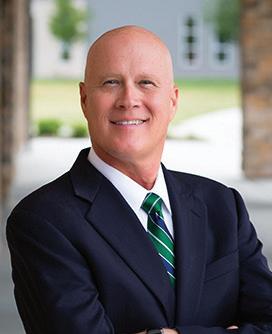
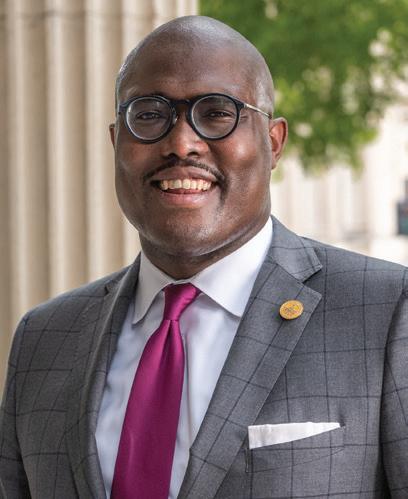
Gordon Silaski: Centennial’s partnership with JA sponsors 27 Arkansas schools in 27 counties through 2023. The sponsorship provides funding allowing school access to JA’s financial literacy programs, resources, mentors and programming in the core-content areas of work readiness, entrepreneurship and financial literacy. JA’s programs provide students with positive realizations and reinforcement of career aspirations, an understanding of money management, and exposure to the benefits of business ownership that help overcome negative, competing environmental factors.
Additionally, the sponsorship provides bank employees with volunteer opportunities such as teaching financial literacy courses at our sponsored schools, special event participation and local participation on boards of directors. JA provides the bank with volunteer recruitment tools, volunteer training and classroom materials.
How important is it to expose students at an early age to programs that foster financial literacy, work readiness and entrepreneurship?
Gary Arnold: Education has always been about the future. I can’t think of three more relevant skills for the future than financial literacy, work readiness and entrepreneurship. Every adult — artists, engineers, counselors, social workers, physicians, coders, landscapers, athletes, the self-employed, etc. — must be able to understand how work builds money, money builds opportunity and opportunity builds one’s future.
Anne Marie Doramus: Very important. Junior Achievement facilitates community leaders, executives and influencers to share their career successes and experiences. This exposes children to the foundations of basic economics at a very young age.

Rush Harding: In a rural state like Arkansas, programs initiated by JA are

essential to transforming our educational system. Young people often think that their culture and environment limit their ability to achieve academically and professionally. Junior Achievement can show them that they have access to a whole new world of opportunities.
Frank Scott Jr.: Well, when one understands that a child needs and has to be able to learn to read by the end of the third grade… They’re reading to learn and learning to read, but really reading to thrive, because if a child is not able to read by the end of the third grade, there is a downstream ripple effect that’s negative.
So, we have to focus on addressing issues that we have seen already very early on from an education standpoint, like reading. We have to do it more so for long-term investment in the potential of our personal and corporate incomes by ensuring that our children learn and are taught at an early age about financial literacy. That helps create long-term posterity and prosperity for communities.
Gordon Silaski: Many of our employees (or their family members) went through a JA program at some point. In addition, we frequently hear from our customers on how they were influenced by concepts and skills first introduced to them in a JA program. It is especially nice when they recall it was a Centennial employee who provided a spark or had a positive influence.
Are schools currently doing enough to help promote these concepts?
Gary Arnold: We can do more. That’s a polite way of saying we are not doing enough. Economics in too many schools has fallen out of favor. Like civics. (Now, there’s an old-school word.) Maybe because it’s tinged with politics; maybe because decision-makers think there are more important things or not enough time; maybe because we are not thinking about the future as much as we think we are.
Regardless of the reason, to send children out into the adult world without a financial compass is a recipe for unnecessary hardship — individual and societal hardship.
Anne Marie Doramus: Yes, I believe the education community is seeing the importance of learning by mentorship and experience.
Rush Harding: Our school systems do a great job with the resources they have. Junior Achievement can supplement their efforts, but we must do our part in getting Junior Achievement into more high schools around the state and seeing to it that the financial resources are available to make a difference in the lives of our young people.
Frank Scott Jr.: Schools are doing some things, and often it’s because of help from Junior Achievement. We need to do more. I think when you think about our community-schools model, we do incorporate financial literacy. There are a lot of corporate members that are aligned with Junior Achievement, but we need to continue to see this expanded.
Regardless of whether they attend a public, private or public-charter school, all students need to have this type of understanding as we move forward. We are grateful to have an organization such as Junior Achievement that has made it its mission to have this type of focus.
How is this commitment to education ingrained into the culture at Centennial?
Gordon Silaski: We are a bank founded by entrepreneurs with a deep and lasting commitment to bettering their communities. As a community-focused bank, we know that Centennial can only be as strong as the individual communities we serve. We focus on giving back with time, talent and financial resources. We seek associates who bring this mindset to the table and communicate our expectations early in the hiring process. Team members across our entire footprint are uniquely positioned to inspire, promote and support financial literacy including basic life and career skills, responsible credit management and home ownership.
Centennial is currently participating in JA’s Virtual Speaker Series, where employees from various companies holding various jobs submit videos explaining the specifics of their career. The videos will form a library, giving teachers a great
resource to help students learn about various career pathways. Seven of our employees were selected to participate.
Since January 2019, Centennial Bank has volunteered more than 1,000 financial literacy hours (not just with JA); 215 service hours with JA; 25 employees have volunteered with JA; and team members Eric King and Tyler Choate (vice chair) both serve on JA’s board of directors.

In what ways have you seen firsthand how the JA mission is making a difference?
Gary Arnold: JA lights a fire in two ways. JA students begin to sense the personal empowerment that comes from financial wisdom, and JA teachers realize they are impacting the absolute future of the next generation. Everyone involved walks away bigger and better. Chances are high this stuff is not being talked about at home. Sadly, if it is being talked about at home, the children who need it the most are being left out of the conversation. JA brings critical life-skills to a diverse, ready-to-learn group of students we call America 2030. JA helps us help our students make better choices for a better future.
Anne Marie Doramus: Many students are impacted by JA. The story of a 17-year-old young woman stands out in my mind. With the help of her JA mentor, she created an embroidered clothing tag for people who are visually impaired that describes what clothing they are shopping for. She is visually impaired herself and saw a need for something that did not exist. Not only did she become an entrepreneur at 17, but she helped remove an obstacle that can change the lives of many.
Rush Harding: Over the last decade, we have seen the hard numbers show the progress we have made, but there is still a long way to go. We need to support Junior Achievement so it can continue to be a meaningful influence on the development of our young people around the state.
Frank Scott Jr.: Anytime you see the children of Junior Achievement in our schools, you can see the impact, not only in the larger youth community but particularly in those of us who are coming from a low income. It’s changing the generation right before his or her eyes.
Gordon Silaski: JA’s mission of inspiring and preparing young people to succeed should be adopted by all of us. It is not enough to help just one person or change one life. That’s good, but we collectively have the capacity to do so much more!
Stop and think — in Arkansas, one in four youth live in poverty, directly influencing their education, career outlook and financial means. Evidence shows that youth who are not exposed to softskills training and early work experience are more likely to be chronically unemployed. In Pulaski County, 17.8 percent of residents live below the poverty line, higher than the national average of 14 percent.
With the help of programs offered by JA, we believe Centennial Bank can foster self-belief and a sense of purpose necessary for young people to thrive and overcome challenging circumstances. Centennial’s partnership with JA helps ensure students will have access to the knowledge necessary for future success.
Bradford House provides skilled professional care in a compassionate and supportive atmosphere. Our licensed nurses, physicians, optometrists, dentists and other specialists believe that building strong relationships with residents and families is essential to the healing process. The entire staff is devoted to providing the quality of care which celebrates the dignity and grace of every single resident.
1202 SE 30th Street
Bentonville, AR 72712




479.273.3430




BradfordHouseNR.com
Bradford House provides skilled professional care in a compassionate and supportive atmosphere. Our licensed nurses, physicians, optometrists, dentists and other specialists believe that building strong relationships with residents and families is essential to the healing process. The entire staff is devoted to providing the quality of care which celebrates the dignity and grace of every single resident.




Bradford House provides skilled professional care in a compassionate and supportive atmosphere. Our licensed nurses, physicians, optometrists, dentists and other specialists believe that building strong relationships with residents and families is essential to the healing process. The entire staff is devoted to providing the quality of care which






1202

BradfordHouseNR.com




 1202 SE 30th Street | Bentonville, AR 72712 | 479.273.3430
SE 30th Street | Bentonville, AR 72712 | 479.273.3430
1202 SE 30th Street | Bentonville, AR 72712 | 479.273.3430
SE 30th Street | Bentonville, AR 72712 | 479.273.3430
When Rush Harding III talks about Junior Achievement, the education nonprofit for which the Crews & Associates CEO has served as benefactor and from which he will receive a Legacy Award on May 27, it’s not long before the subject transitions to his Delta upbringing and connection to JA/Arkansas founder Sheffield Nelson.
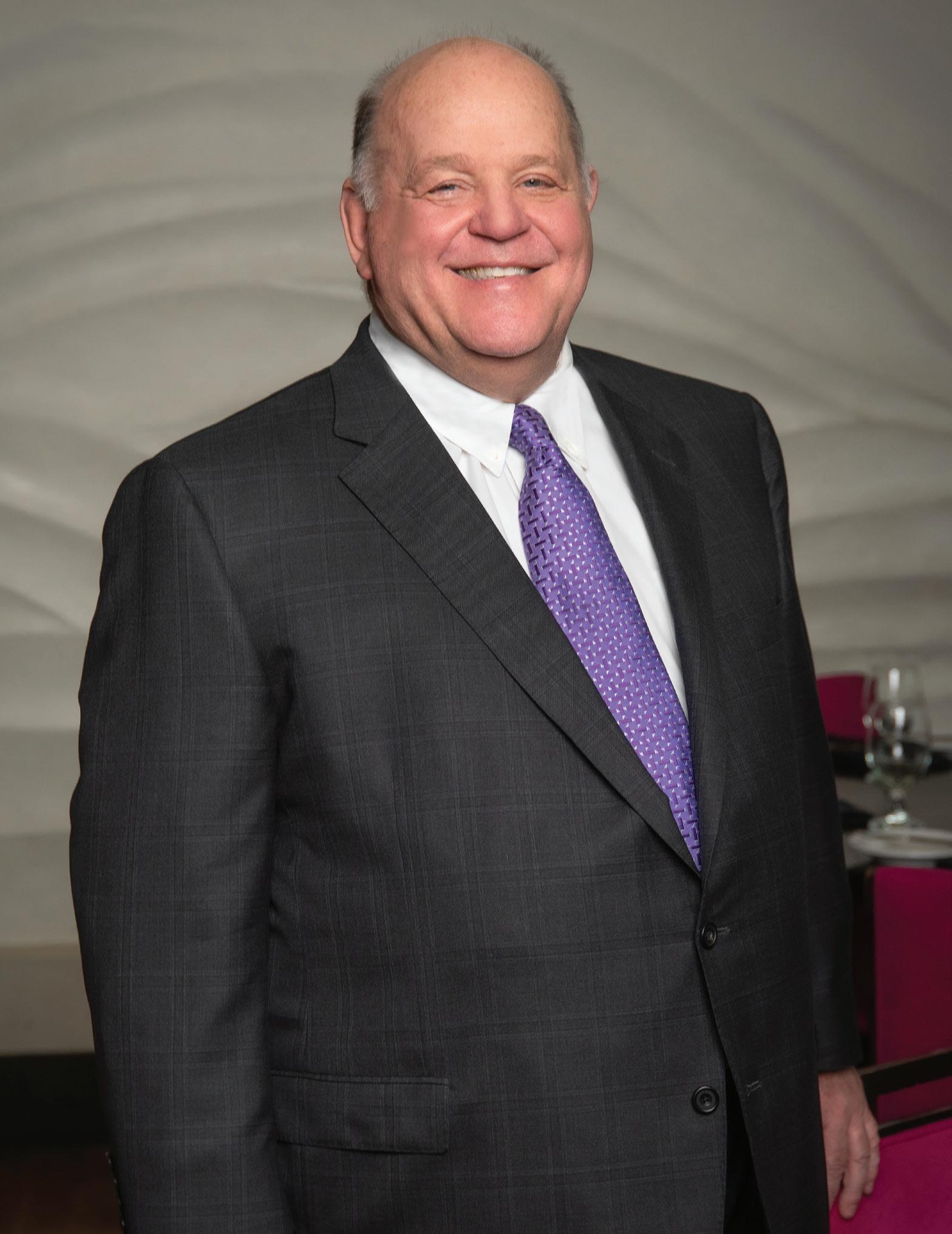
Since his days as an all-star athlete at Clarendon High in the early 1970s, Harding’s plan was to follow the trail of breadcrumbs left by Nelson, a fellow Monroe County native who was close to the Harding family and to whom Rush looked up.
“He put a stamp of excellence on everything he did,” Harding said of Nelson.
Indeed, the young Harding watched as Nelson excelled at nearby Brinkley High, both as student body president and a standout athlete, all while maintaining an after-school job to help support his family. He eventually became the student government president at what’s now the University of Central Arkansas. After graduation from UCA, Nelson went to work — at the behest of Witt Stephens — for Arkansas Louisiana Gas Co., then known as Arkla and now better known as CenterPoint Energy.
He worked his way up the ranks, attending law school at night. And at age 32, Nelson was handpicked by Stephens to become the youngest CEO of a public utility in the country. Harding, meanwhile, recognized a template when he saw one.
“Sheffield was mentoring me, maybe not even consciously, in those early years, but in terms of how he was a leader in his
school, how he was a leader on the athletic teams, everything he did,” Harding said. “I wanted to be like that.”
Right down to their support of JA and its mission of promoting financial and economic literacy in schools, Harding followed that path. Nelson brought Junior Achievement to Arkansas in 1987, and Harding was a disciple of its message from the get-go. The son of teachers in Clarendon (his dad was also the football coach and is a member of the Arkansas Sports Hall of Fame), he appreciated the value of education from an early age.
Harding recognized that for many, education represented the only ticket out of the Delta, which was by then becoming depopulated and impoverished, as mechanization required fewer bodies to work the farms.
“In my graduating class of 52, maybe five kids went to college,” Harding said. “I had a great advantage over most kids because my mom and dad were educators and believed in education. I love the Delta, and it’s a great place to live and raise your family. But if you ever want to be able to transcend the financial limitations that are put upon you by being from that part of the state, education is the way you’re going to do it.”
Like Nelson in Brinkley, Harding was a star athlete in Clarendon and student body president. But his path to UCA took a detour north when he accepted a commission to the United States Military Academy.
“I loved West Point, but knew I didn’t want to be a soldier,” Harding said. “I thought I was going to college but found out I was joining the Army. I was in the Army getting an education and not just going off to college. So, I resigned my commission and transferred to UCA, where I’d always wanted to go.”
Harding’s been a strong supporter of Junior Achievement and education in general since graduating from UCA and landing in Little Rock under the wing of financier Adron Crews in 1979. One of seven founding partners at Crews & Associates,
Harding was determined to emulate Nelson and rise in the ranks of the Little Rock business community. And just like Nelson, Harding gave back as he ascended.

And now, at its annual awards luncheon, Junior Achievement of Arkansas will recognize Harding for “exceptional leadership” in promoting education. Also receiving Legacy awards are Anne Marie Doramus of Arkansas Bolt and Little Rock Mayor Frank Scott Jr. Plus, Dr. Gary Arnold of Little Rock Christian Academy is the Educator Award honoree. And Centennial Bank is the winner of the Nelson Summit Award, recognizing a business that shows a commitment to education.
Over the decades, Harding’s enthusiastic philanthropy has benefitted the likes of UCA, Hendrix College, Philander Smith College, Pulaski Academy, Easter Seals, Habitat for Humanity, the Methodist Foundation for Arkansas, the Arkansas Symphony Orchestra and more. UCA recently announced a $3 million estate gift, the latest of many, from Harding and his wife, Linda. The 2021 gift is part of the school’s latest fundraising campaign, which seeks to raise $100 million by 2024.
Harding was named a UCA distinguished alumnus in 2007, again following in Nelson’s footsteps. In 1986, Nelson was a part of the school’s first distinguished alum class. Now 80, Nelson is retired with wife, Mary Lynn, in Little Rock. In 2019, he told Arkansas Money & Politics that he hopes JA has a lasting impact.
“I think education is such a key to life. That’s what pushed me. I didn’t become president of Arkla until I’d finished my degrees and worked my way through the ranks,” Nelson said. “My education provided such a great boost to me in moving up in the company. I think that will hold true for a lot of Arkansans. An education is something that has to be pushed hard.
That’s got to be a major strength for Arkansas to grow the state economically.”
Harding believes it takes just one “committed educator” to make a difference in the life of a young student.
“There are too many educators who just show up,” he said. “There’s no one more underpaid than a great teacher and nobody more overpaid than a bad one. And a lot of times, teachers just write kids off and don’t think they can learn. But the only way you’re ever going to change the economics of rural Arkansas, Mississippi, Alabama, Louisiana, the only way you’re ever going to change the fundamental economies of those areas, is one kid at a time.”
He’s seen one educator make such a difference in his own hometown. In 2011, the Teach for America program sent Jeremy Rogoff to Clarendon for a two-year assignment teaching high-school algebra and
“Sheffield was mentoring me, maybe not even consciously, in those early years, but in terms of how he was a leader in his school, how he was a leader on the athletic teams, everything he did I wanted to be like that.”Sheffield Nelson, circa 1989
Spanish. Rogoff now is the CEO and co-founder of Philadelphia’s Kickup, which provides professional learning for teachers.
But before he headed back to his native Pennsylvania, Rogoff challenged his Clarendon students to meet certain goals. The carrot was a trip to New York City, for which he hoped to raise money for expenses. And the students delivered. One hundred percent of his algebra students passed the state’s end-of-course assessment, and 100 percent of his Spanish students passed the New York Regents Proficiency Exam. These achievements set district records and surpassed previous passage rates by 40 percent.
Rogoff took 28 students from rural Arkansas to New York on a $43,000 budget funded through more than 200 private gifts and support from charitable

foundations.
“He was determined that every one of those kids was going to succeed,” Harding said. “He was going to break the trend. Who would ever dream of trying to put that together?”
Tonya Villines, executive director of JA/ Arkansas, believes that’s the kind of commitment students deserve. She’s seen it exhibited through Monroe County’s own in Harding and Nelson.

“One of the greatest challenges of leadership is making vision stick,” she said. “Vision doesn’t have much adhesive without constant care and attention. Sheffield has promoted inspiration, passion, enthusiasm and commitment throughout Arkansas and made significant impact on economic and youth development. He has a servant heart for contributing to the lives of others, and so does Rush Harding.
“Rush’s commitment to his community and his leadership have established a firm foundation for Arkansans to pursue careers in business and build strong partnerships with the business and education community. Rush has made a profound impact here in Arkansas, and we are grateful for his positive contributions in the communities we serve.”
Since Nelson got the ball rolling in 1987, Junior Achievement of Arkansas has impacted more than 295,000 students. Vil-
lines said JA presents a starting point for many students to begin thinking about what their dreams might look like.
“We are committed to inspiring these young people to become independent, competent and career- or college-ready,” she said. “Today, we are providing solutions for schools in the face of COVID-19 by creating pathways, embracing digital programming and creating change to prepare today’s youth for tomorrow’s economy. This is taking us from just delivering a program to providing a pathway for students with badges and certifications.”
JA helps equip the next generation of leaders with knowledge, skills and the capacity to be successful, Villines said. And that includes helping provide higher standards of living and driving economic development — and promoting economic empowerment — in communities across the state.
“Our work can help with a number of societal issues including changing the cycle of poverty, improving education disparity, closing the achievement gap, improving the talent pipeline, increasing youth self-efficacy and promoting equality,” she said.
As his star continued to rise in the Little Rock business community, Harding thinks Nelson looked at him as something like a little brother from Monroe County.
“Then our friendship and respect for each other has grown,” he said. “But the common denominator in that thread of continuity through six decades was mentorship and education. And those are the two primary things that Junior Achievement stands for.”













Family is big in Arkansas, and it stands to reason that so are family businesses. Generational businesses are the backbone of business in the Natural State, and while we don’t claim to have a comprehensive list of every family operation out there, we nevertheless can shine a spotlight on some of the state’s prominent family-run stores, companies and firms.
Arkansas Money & Politics is proud to once again recognize generational businesses in Arkansas.
Ace Glass Construction Corporation
Windows/Glass, Little Rock
Akel’s Carpet One Carpet/Flooring, Little Rock
Albright Ideas
Advertising, Little Rock
Alford’s Carpet One Floor & Home Decor, Fort Smith
Anthony Timberlands
Wood Supplier, Malvern
Arkansas Graphics Inc. Printing, Little Rock
Arkansas Mailing Services Mailing Services, North Little Rock
Bank of England
Banking, Little Rock
mon’s son Thomas has led the company since 2010 and added real estate to the company’s portfolio.
Blackmon Auction provides more than 80 years in the industry, an average of around 70 auctions a year and employees who average 15 years of service.

Blakeman’s Fine Jewelry
Jewelry, Rogers
Bray Sheet Metal
Sheet Metal, Little Rock
Brown Boys Roofing
Home Improvement, Bentonville
Bruno’s Little Italy
Restaurant, Little Rock
Cavender’s Seasoning
Culinary, Harrison
CBM Construction
Construction, Little Rock
my family, and I am proud to say we are a third-generation company.
“Gabe and I work every day in an industry that we love, and we will work to continue to see the C.C. Jones name running up and down our highways.”
Central Flying Service
Aerospace/Aviation, Little Rock
Chi’s Chinese Cuisine
Restaurant, Little Rock
Clark Machinery Company
Construction Services, Fort Smith
Cogswell Motors
Auto Dealership, Russellville
Cooper Family Dentistry
Dental, Jacksonville
Coulson Oil Company
Petroleum Distribution, North Little Rock
Cozy Cavern Storm Shelters
Emergency Preparedness, Austin
Auctioneer, Little Rock
The first-ever Blackmon auction was conducted in 1938 by founder Eddie Blackmon Sr.
The story goes that Blackmon owned part interest in a cattle barn in DeWitt, but the auctioneer who was working for him got into some trouble running a scam and was run out of town. In his absence, Blackmon did the auction that night, and the rest is history.
Years later, in the ‘60s, Tom Blackmon Sr. took over the business, expanding it from a seasonal operation to a full-time business. He focused heavily on selling farm equipment, but in the ‘70s added construction-equipment auctions and in the ‘80s began including trucking, logging, railroad and manufacturing equipment. Under his leadership, Blackmon Auctions evolved from a regional business to a full-blown auction company that earned international renown. Black-
CC Jones Trucking

Trucking, North Little Rock
C.C. “Shorty” Jones started his North Little Rock trucking company in the late 1940s with one truck. He used that truck to haul poultry out West and bring produce back to Arkansas. Today, C.C. Jones Trucking is run by Shorty’s daughter, Vicki Stephens, and her son, Gabe Stephens.
C.C. Jones has been named an Arkansas Trucking Association Safety Award winner each year for more than a decade including being named grand champion, and it carries the highest Department of Transportation safety rating.
Vicki went to work for her dad in 1966 and never left.
“Mother and I used to ride with Dad when I was a little girl, and he would tell me stories about the states I had seen,” she says. “I have met many wonderful people, made many lasting friendships and made positive contributions to this industry. This industry has been good to
Crews and Associates
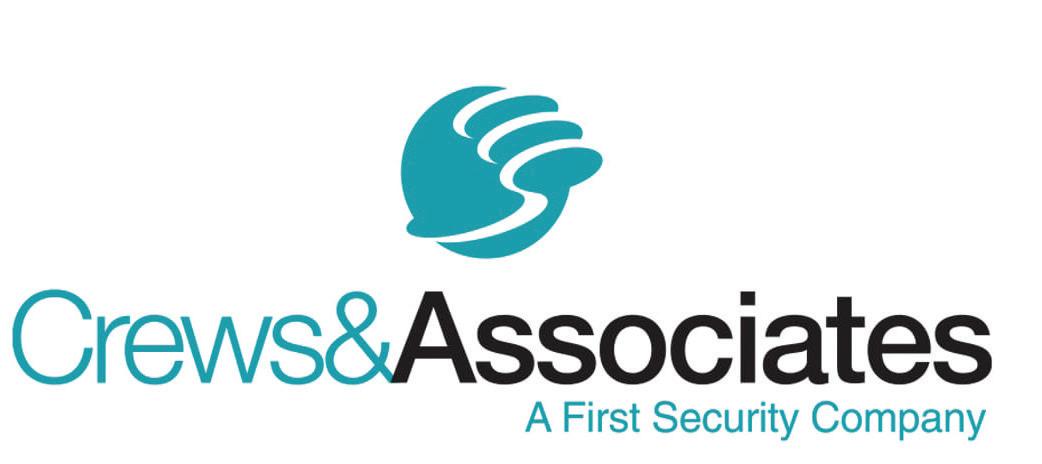
Banking, Little Rock
Crews & Associates offers fixedincome sales and trading, financialadvisory services and capital-markets financing. It has dedicated professionals serving clients in Arkansas and across the country and is led by founding partner and CEO Rush Harding III. His son, Rush “Buddy” Harding IV serves as senior vice president.
In an industry marked by upheaval, Crews is known for 40 years of service, dedicated leadership and deep roots. The firm is supported by First Security, its $7 billion-plus bank-holding company, as well as more than $1.4 billion in total capital. Institutions, individuals and communities partner with Crews to navigate markets and achieve financial goals.
Crow Burlingame
Auto Parts, Little Rock
Curry’s Termite and Pest Control
Pest Control, Little Rock
CustomXM
Printing/Promotional, North Little Rock
Daniel Orthodontics
Dental, Little Rock
DASH Heating and Cooling
HVAC, Little Rock
DataPath Inc. Employee Benefits/Tech, Little Rock
David’s Burgers Restaurant, Conway
Delta Land Management Co. Real Estate, North Little Rock
Diamond Center Jewelers Jewelry, Fayetteville
Dillard’s Clothing, Little Rock
DJ’s Auto Repair Auto Repair, North Little Rock
former Arkansas governor Bill Clinton, and when Clinton was elected president in 1992, his taste for Doe’s went with him to the White House.
When candidate Clinton was interviewed for a cover story in Rolling Stone, Doe’s served as the setting. Eldridge and former Doe’s chef Lucille Robinson even got to attend the inaugural ball. Doe’s remains family-owned and operated. George’s daughter, Katherine Eldridge, assumed ownership in 2012 and is continuing the Doe’s tradition. Famous for its patios, including the dog-friendly back patio, Doe’s still attracts politicians and celebrities while maintaining its down-to-earth atmosphere.
Located at the corner of Ringo and Markham in downtown Little Rock, Doe’s has new hours — Tuesday through Saturday for lunch from 11 to 2 and Friday and Saturday for dinner from 5 to 10.
Don’s Supply
Restaurant Supply, Little Rock
Duffield Gravel Co. Quarrying, Mineral Mining, Russellville
EC Barton & Company Retail, Jonesboro
Faded Rose Restaurant Restaurant, Little Rock
Feltner’s Whatta-Burger Restaurant, Russellville
Ferstl Valuation Services
Real Estate Appraisal, Little Rock
Fuller & Son Hardware
Hardware, Little Rock
Garrett Excavating Construction Services, Benton
Gaston’s White River Resort
Resort, Lakeview
Generations Bank
Banking, Fayetteville
George’s Chicken
Food Manufacturing, Springdale
Graham Hardware
Hardware, Wynne
Grandeur Fasteners Inc.
Manufacturing, Danville
Gwatney Chevrolet Company
Car Dealership, Jacksonville
Harp’s Food Stores
Grocery, Springdale
Harrell Bancshares
Banking, Camden
Hathaway Group
Real Estate, Little Rock
Hugg & Hall
Equipment Rental, Little Rock
Hum’s Hardware and Rental Construction Services, North Little Rock
Humphrey Funeral Service
Funeral Home, Russellville
Doe’s Eat Place Restaurant, Little Rock
Doe’s Eat Place originated, of course, in Greenville, Miss. George Eldridge, a restaurateur and hobby pilot from east Arkansas, for years had been flying friends and clients to Greenville for steaks at Doe’s.

Eventually, he decided to “bring the mountain to Mohammed” and contracted the right to bring the name and menu to Little Rock. Opened in 1988, Doe’s Little Rock maintains the no-frills tradition of the original and has achieved its own renown as a regional — and even a national — favorite. Doe’s was a favorite of
First Arkansas Bank & Trust Banking, Jacksonville
First Arkansas Bank & Trust Banking, Sherwood
First Security Bank
Banking, North Little Rock
Fort Thompson Sporting Goods Sporting Goods, Sherwood
Freyaldenhoven
Heating & Cooling HVAC, Conway
Innerplan Office Interiors
Office Interiors, North Little Rock
Iriana’s Pizza
Restaurant, Little Rock
Jan Pro Cleaning Services
Cleaning, North Little Rock
K Hall & Sons Produce
Grocery, Little Rock
Kitchens Pediatric Dentistry
Pediatric Dentists, Little Rock
Kittle’s Garage
Automobile, North Little Rock
Leonard’s Hardware Inc.
Hardware, Russellville
Lewis Ford Sales Inc.
Car Dealership, Fayetteville
Lexicon
Construction, Little Rock
Lift Truck Service Center
Heavy Equipment, Little Rock
Lindsey’s Hospitality House
Restaurant, North Little Rock
Maple Leaf Awning and Canvas
Outdoor, Sherwood
Martinous Oriental
Rug Company
Decor, Little Rock
Mays, Byrd & O’Guinn, PLLC.
Legal, Little Rock
McCauley Services
Pest Control/ Electrical, Bryant
McClendon’s Appliance
Repair, Benton
Meyers Supply and Chemical
Janitorial Equipment Supplier, Hot Springs
Miller’s Drug Store
Pharmacy, Malvern
Moon Distributors
Distribution, Little Rock
Nabholz
Construction, Little Rock
National Custom Hollow
Metal Doors & Frames
Hardware, Little Rock
Oaklawn Racing Casino Resort
Gambling, Hot Springs
Oaklawn Racing Casino Resort, the state’s most popular tourist attraction, has been around since 1904. Among Oaklawn’s founding partners were brothers Louis and Charles Cella, who eventually gained complete ownership in 1916. Louis, however, died two years later making Charles Cella the sole owner.
Cella grew the popularity of horse racing across the state and hosted the first Arkansas Derby at Oaklawn in 1936. It had a purse of $5,000. Since then, it has traditionally been held there each year and the purse has increased to $1 million.
After 48 years in racing, Cella passed away in 1940 leaving ownership to his son, John, and grandson, Charles. They continued to market Oaklawn to increase crowds. Charles became president of Oaklawn in 1968 after the death of his father.
The family tradition of promoting racing and expanding Oaklawn passed on to son, Louis Cella, in 2017 after Charles passed away. Oaklawn just opened its $100 million expansion project that includes a seven-story luxury hotel; a 14,000-square-foot, multipurpose event center; and an additional 28,000-squarefeet of gaming space. The project represents one of the largest private investments for the state’s hospitality and tourism industry.

Parrish Delivery Services
Mail/Courier, Little Rock
Peneprime of Arkansas
Asphalt, Little Rock
Peters Family Living
Furniture, Russellville
Pettus Office Products
Office Supplies, Little Rock
Phelan Orthodontics
Orthodontics, Little Rock
Phil Wright Autoplex
Auto Dealership, Russellville
Pine Bluff Sand and Gravel Co.
Aggregates, White Hall
Poe Travel
Travel, Little Rock
Power Technology Inc.
Lasers, Alexander
Ranalli Farms
Grocery, Farm Equipment, Feed, Springdale
Red River Auto Group
Auto Dealership, Jacksonville
Refrigeration and Electric
Supply Co.
Hardware, Little Rock
Richards Honda Yamaha
Automotive, Little Rock
Richards Honda Yamaha is the oldest Honda dealer in Arkansas, serving Arkansans since 1945. Richards Honda Yamaha offers a wide selection of Honda and Yamaha motorcycles and ATVs.

In early 1946 at the end of World War II, Dan Richards Sr. reopened the HarleyDavidson store once owned by his fatherin-law on Asher Avenue in Little Rock. This proved to be a wise decision — Little Rock was starving for a motorcycle store. Dan Sr. (D.W.) immediately began to make his presence known and that of his business by racing every chance he could. In 1960, D.W. added another franchise to his Harley dealership — a littleknown Japanese company named Honda that had begun selling in the United States.
D.W. liked the promise Honda showed. Richards Cycle Center became the 195th Honda dealer in the United States. With Honda’s instant success and the continuing sales of Harleys, Richards Cycle
Center grew and saw several face-lifts over the ensuing years. A branch store was set up at 19th and University Avenue for a short time. It was called University Honda Center. Since then, the family has grown, and so has the business. With three generations of family involved in the business, Richards has the skills and experience needed to best serve Arkansans looking for a classic ride.
Riggs Cat Heavy Equipment Dealer
Heavy Equipment, Little Rock
Ritter Communications
Telecommunications, Searcy
Roller Funeral Homes
Funeral Home, Little Rock
Russell Chevrolet and Honda
Automotive, North Little Rock
Sissy’s Log Cabin
Jewelry, Little Rock
Smith Ford
Automotive, Conway
Smith North Little Rock
Funeral Home
Funeral Home, North Little Rock
Sol Alman Company
Recycling, Little Rock
Sportstop Inc.
Sports Apparel, Little Rock
Star Bolt
Fasteners, North Little Rock
locations in strategic domestic markets and a European presence in England and Germany.
Stephens is committed to building long-term value for corporations, state and local governments, financial institutions and institutional and individual investors. Stephens’ affiliates include: Stephens Inc. (offers securities products; member NYSE SIPC), Stephens Investment Management Group, Stephens Insurance LLC, Stephens Capital Partners LLC and Stephens Europe Limited. For more information, visit www.stephens. com/.
T&S Sawmill Inc.
Sawmill, Clarendon
Tipton & Hurst
Floral, Little Rock
Today, Triple S Alarm has a wide host of knowledge and surveillance products, including mass notification, access control, video surveillance, nurse call, audio/ video solutions, paging/intercom systems, U.L. certifications, testing and inspections and its own in-house U.L. Central Monitoring Station. Triple S Alarm looks forward to serving Arkansas for generations to come.
Tyson Foods
Food, North Little Rock
Underwood’s Fine Jewelers
Jewelry, Fayetteville
Venesian Inn
Restaurant, Tontitown
War Eagle Boats
Aluminum Boat Manufacturing, Monticello
Wardlaw Orthodontics
Orthodontics, Little Rock
Warren’s Shoes
Stephens Inc. Finance, Little Rock
Stephens is a leading family-owned investment firm comprising the businesses of investment banking, advisory, sales and trading, research, insurance and wealth management. Founded in 1933, Stephens’ U.S. operations are headquartered in Little Rock with additional

Founded in 1975, Triple-S Alarm Co. is one of the largest family-owned security companies in the South. The business was originally started by Seth Ward and Rick Edwards as a residential security company. In 1980, Rick and Mary Edwards purchased all the stock in the company and since then have grown Triple-S into what it is today. Along with sons, Roderick and Chad, who manage day-to-day operations, the Edwardses have built Triple-S into one of the largest family-owned, low-voltage contractors in the South. Triple-S covers the entire state from offices in Little Rock, Pine Bluff and Northwest Arkansas.

“Most business owners and homeowners require peace of mind and reliability when it comes to monitoring their systems,” Roderick says. “When a fire alarm, panic or break-in occurs, a quick response by fire, police and medical can mean the difference in life or death. That’s why Triple-S Alarm provides our own in-house UL Central monitoring station. Rest assured that professional operators will respond to your every need, 24 hours a day, seven days a week.”
Women’s Shoes, Paris
Welsco
Welding, Little Rock
Whisinvest Realty, LLC
Commercial Real Estate, Little Rock
Williams Tractor
Tractor Dealership, Fayetteville, Springdale
Wilson Law Group
Legal, Little Rock
Wilson Real Estate
Auctioneers, INC.
Auctioneer, Hot Springs
Wooley Auctioneers
Auctioneer, Little Rock
WWW/AFCO Steel Inc.
Construction Steel Fabrication, Little Rock
Xpress Boats
Boat Manufacturing, Hot Springs










top laser companies in the nation is located in a large but nondescript building on a lonely road in the small town of Alexander, just outside southwest Little Rock.

Yet Power Technology Incorporated (PTI) manages to thrive, with its staff of more than 50 engineers and experts constantly crafting an ever-stronger array of products. Overseeing it all are the twin-brother team of William and Walter Burgess, who took over from their father and PTI founder, Thomas, in 2006. Under their guidance, PTI has maintained its dominance in the state’s surprisingly large community of laserrelated businesses.
In fact, William is the founder and head of the Arkansas Photonics Industry Alliance, a trade group that represents the state’s 16 companies in the industry, which encompasses the marriage of protons and electronics. More than 500 people across Arkansas are employed in the field, which generates $111 million annually for the state’s economy.
“We’re global with our marketing and global sales happening out of this office and a sales team that has some focus on overseas sales, some on the semiconductor sector and some life sciences,” said William, who is vice president of operations handling the production and finance side of PTI. “We export 24 percent of everything we make, and last year we exported to 47 countries. That’s 46 more than the average U.S. company exports to, and President Obama even gave us the E Award for exports.”
One might expect a business on the cutting edge of lasers, providing the latest in precision technology to everything from movie theatre projectors to missile guidance systems for national defense, to be located in a sleek building headquartered inside a top-secret research campus. Therefore, it’s surprising that one of the
The President’s E Award from the U.S. Department of Commerce recognizes those companies that contribute significantly to increase U.S. exports.
Arkansas laser manufacturer is a big player in industry and a family affairThese days, lasers come in much smaller sizes.
PTI manufactures three distinct types of lasers: semiconductor, gas-based and crystal-based. The semiconductor lasers create pulses like flashes on a camera, which facilitate putting a lot of light out quickly — a key aspect in missile-guidance testing and defense programs, as well as mapping human eyes before surgeries.
The 25,000-square-foot headquarters has been PTI’s home base since 2001, and the company has been in existence for more than 50 years. Amid its facilities is a special “laser room” that measures the precision of lasers by bouncing beams back and forth among mirrors, which allows staffers to see the angular tolerance of a beam and how much error it has on its way to perfection. That accuracy is measured in milli-radiants, or small fractions of degrees.
Perhaps the most intriguing space in the building is its “clean room,” which utilizes a filtration system to remove even the most microscopic particle of dust. A single dust speck will cause a laser to scatter light, ruining the ability to have a pure, high-quality laser beam, so PTI is determined not to trap any particles between the laser and the lens.
Crystal-based lasers are also a key part of defense products generated at PTI, with major secrecy enforced not only by the company itself but also the regulations of International Traffic and Arms Regulation (ITAR). The engineers also align laser diodes to link semiconductor lasers to fibers that are as tiny as four microns, or 4/1000th mm in diameter.
“Our lasers are manufactured usually in a black metal tube. Black’s really good for optical purposes because it doesn’t reflect light,” William explained. “When one is ready for fiber couplings, by end of day we’ll load it with optics. Make the precision happen by controlling temperature closely, control the temperature of the laser to .02 degrees accuracy. If this was outdoors, even though the temperature is fluctuating, the laser doesn’t move more than .02 degrees the whole day.”
William believes that PTI leads the nation in the creation of helium neon lasers.
Another unusual capability is that the company makes its own circuit boards, which laser companies usually outsource. In-sourcing is a key part of PTI’s ability to control costs and delivery times, and the company can place 6,000 circuit chips every hour.
Defense technology makes up 20 percent of PTI’s business, with life sciences and semiconductors the other leading markets for the company. It stockpiles more than 10,000 parts in its stockroom, with computer algorithms monitoring supplies weeks before they can possibly run out.
“We’re not after a million-piece order from companies because that’s going to go offshore and be made somewhere really cheap,” said William. “We want the hightech focus of hundreds or a thousandpiece order. We use a consultative process with our clients where we say, ‘Here’s what we’ve done in the past; we think this will be successful for you. Do you agree?’”
With such highly complex decisions made on a constant and rapid basis, it helps that the Burgess brothers, who are 47, are twins with much of the same mindset. Walter noted that he and William are essentially co-CEOs, with their responsibilities divided according to their respective strengths, and he’s in charge of sales and engineering.

“It might not be a surprise, but we spent the first 20 years of our lives together,” Walter said. “We shared experiences, challenges and triumphs during that time
that shaped who we are today. Coming from an almost identical youth, we almost always reach the same conclusions to a given challenge. We may occasionally have differing opinions on the ‘how’ when it comes to a goal, but we almost always agree on the goal or strategic direction itself.”
While none of their own kids have expressed interest yet in taking the reins of PTI in the future, William notes that surviving more than 50 years already in such a competitive field is an outstanding achievement in itself. In keeping with their close-knit brotherly mindset, Walter builds on that for what is perhaps the best summation of what PTI has been over five decades.
“I am always proud to be a part of one of Arkansas’ oldest technology companies. When Thomas, my father, started the company, the number of ‘technology’ companies in the state could be counted on one or two hands,” he said. “There were no great incubators like those run by the Venture Center, the Conductor or Startup Junkie. Thomas had to figure out entrepreneurship with much less support than what is available today.
“There is no telling what the future will hold,” he added, concerning the prospect of his children taking on a third generation of leadership. “When I was 16, I had a summer job at Power Technology digging ditches. I swore I would never work here after that summer. I have been here 25 years now. There is a lot of truth in the saying, ‘Never say never.’”

The business of energy has always been an uncertain industry, filled with terrific highs and horrendous lows. At the moment, Arkansas is on a high with solar energy. According to the U.S. Department of Energy (DOE), the country’s solar power capacity has grown from .34 gigawatts (GW) in 2008 to a current estimated 97.2 GW — enough to power the equivalent of 18 million average-sized homes.
As solar energy becomes more affordable, accessible and therefore more popular, environmentalists aren’t the only ones pleased. Business owners and workers in the solar industry are reaping the benefits of a growing industry as well. Solar has induced a job-growth rate of 167 percent over the past decade, five times faster than the overall job growth rate for the U.S. economy. Currently, more than 250,000 people work in solar-related jobs across the country spanning project development, manufacturing, trade, distribution, installation and more, according to the Solar Foundation’s National Solar Jobs Census.
Where does Arkansas fall in all of
this? It’s no surprise in national rankings from the Solar Energy Industries Association (based on cumulative solar capacity installed) that California leads the way with more than 31,000 MW and the capability to power more than 8.4 million homes. Texas, North Carolina, Florida and Arizona respectively claim the remaining top five spots. Arkansas hovers in the
middle of the pack, ranked as 29th in the country with a capacity of more than 381 MW, which is enough solarinstalled power for more than 43,000 homes. Ranked at the bottom of the list are North Dakota, South Dakota, West Virginia and Alaska.

Experts are very optimistic about Arkansas’ growing role in the solar energy sector. Sierra Club Arkansas Director Glen Hooks asserted that,
“The Arkansas solar energy boom is real, and it’s happening right now.” He credits rapidly falling solar energy prices and the passage of Act 464 for the growth we’re seeing in the state. In 2019, Act 464 expanded net metering and enabled third-party financing for solar systems. According to Hooks, the change in legislation removed barriers that had hampered full participation in solar. Since then, there has been

Experts are very optimistic about Arkansas’ growing role in the solar energy sector.Solar arrays in Morrilton (left) and Jefferson County.
an ever-increasing number of school districts, cities, counties and municipal utilities buying into solar energy.
Following a price drop of 45 percent over the last five years, nearly half-a-billion-dollars’ worth of solar investments have been made in the state, and it is believed the number of solar energy installations will continue increasing over the next several years. The Solar Energy Industries Association projects Arkansas will reach 1,179 MW over the next five years and move up to 28th place. The outlook means employment numbers should climb as well. Today, Arkansas is home to 25 solar companies (two manufacturers, 14 installers/developers, 10 others) and provides 329 solar jobs.
For a long time, the environmental aspect of clean energy has been the driving force for many who choose it. But now more individuals, businesses and government entities are seeing economic benefits of solar energy and joining in. “Solar energy is no longer the future,” Hooks noted. “It’s the present, and it’s bringing the gift of good jobs and a cleaner environment to the Natural State.”
Aside from the environmental impact, solar energy provides economic rewards for businesses and for the communities around them. Former Arkansas lieutenant governor and current Scenic Hill Solar CEO Bill Halter explained that while solar energy reduces greenhouse gases, lowers water consumption and improves lung and heart health, it also provides financial wins for users. According to Halter, solar energy provides Arkansas with the following:
• Reduced electricity costs;
• Price certainty and a hedge against electricity price increases;
• Local economic impact including capital investment and local employment;
• Enhanced tax base for communities;
• Heightened recruitment of industries and companies with sustainability goals .
Scenic Hill Solar performs projects in all parts of the state. In 2017, it was responsible for installing a 3,528-panel solar array for L’Oreal’s North Little Rock factory. The 1.2 MW array provides about

10 percent of the factory’s power, with remaining power coming from North Little Rock’s Murray Hydroelectric Power Plant. Other major installations include Arkwest Communications, Bank OZK, Central Arkansas Water and several city projects. Scenic Solar’s work performed for Producers Rice Mill is the largest nonutility solar power plant and battery storage project in Arkansas.
North Little Rock-based Seal Solar is another top-performing solar company with installations underway in every size and scope, from 11,000-panel arrays for Lexicon Fabricators and Constructors to the state’s largest county-owned and rooftop solar array. Currently, Seal Solar is working on residential, commercial, government, agricultural and historic projects across the state — including an increasing number with panels, batteries and electric vehicle (EV) chargers. According to Co-founder and President Heather Nelson, following its investment in Evolve Auto — the only exclusive EV car dealership in the Southern United States — Seal Solar plans to provide a fully solar-powered ecosystem. It will
include panels, batteries, EV chargers and cars to provide clients with a complete package for energy independence.
Additionally, one of the state’s largest electric companies, Entergy Arkansas, recently received approval by the Arkansas Public Service Commission for a new utility-scale solar project that will provide Entergy Arkansas customers with 100 MW of solar power and 10 MW of backup battery storage to use when the sun isn’t shining. The Searcy solar project in White County will be the largest utility-owned solar project in the state and the first to feature battery storage. When completed in 2021, it will be the third project generating solar energy for Entergy Arkansas’ customers, bringing the total of solar energy to 281 MW covering more than 2,000 acres, enough to power about 45,000 homes.
This comes following a settlement with Sierra Club that was finalized in March of this year. The settlement agreement requires the closure of the Lake Catherine gas plant (528MW) by 2027, White Bluff coal plant (1.639MW) by 2028 and Independence coal plant (1.657MW) by 2030. The settlement also requires 800MW of new wind solar or storage by 2027, 400MW of which must be lined up by the end of 2022.
Industry leaders are optimistic that the solar energy sector will continue to grow and provide financial good fortune for the state. Nelson noted, “Despite COVID-19, 2020 was a banner year for the state’s renewable energy industry.” Seal Solar alone completed a record 250 projects, established a Northwest Arkansas satellite office, relocated to a larger warehouse space and more than doubled its workforce.
Hooks attested that Arkansas has become a “bona fide energy efficiency leader” in the southeast. “Now that we have a history of success in this area,” he noted, “I expect that our Arkansas leaders will want to expand this success into other non-utility areas, such as improved building codes, increased electric vehicle infrastructure and requiring more energy-efficiency measures from our state’s large industrial consumers. The economic and associated benefits of energy efficiency are simply too strong to ignore.”
Sunpro Solar Maumelle
AEV Solar Little Rock
Seal Solar Little Rock
Arkansas Solar Power Inc. Little Rock
Sun City Solar Little Rock
Stellar Sun Little Rock
LibcoSolar Hot Springs Village
SunRun Sherwood
Delta Solar Little Rock
Solar Source Consulting Little Rock
Today's Power Inc.
North Little Rock
SunRun Solar Supplier Solgohachia
Perihelion Solar Russellville
SunRun Solar Hackett
Abundant Energy of Arkansas
Booneville
Allen Energy Broker Pine Bluff
Battery Systems of Little Rock Little Rock
Shine Solar LLC
Arkansas' Best Solar Co.
Rogers
Pearcy
Go Solar Arkansas Springdale
Solar Solutions
Mountain Home
New Farm Solar Springdale
Entegrity
Scenic Hill Solar
Universal Power
Little Rock
Little Rock
Jonesboro

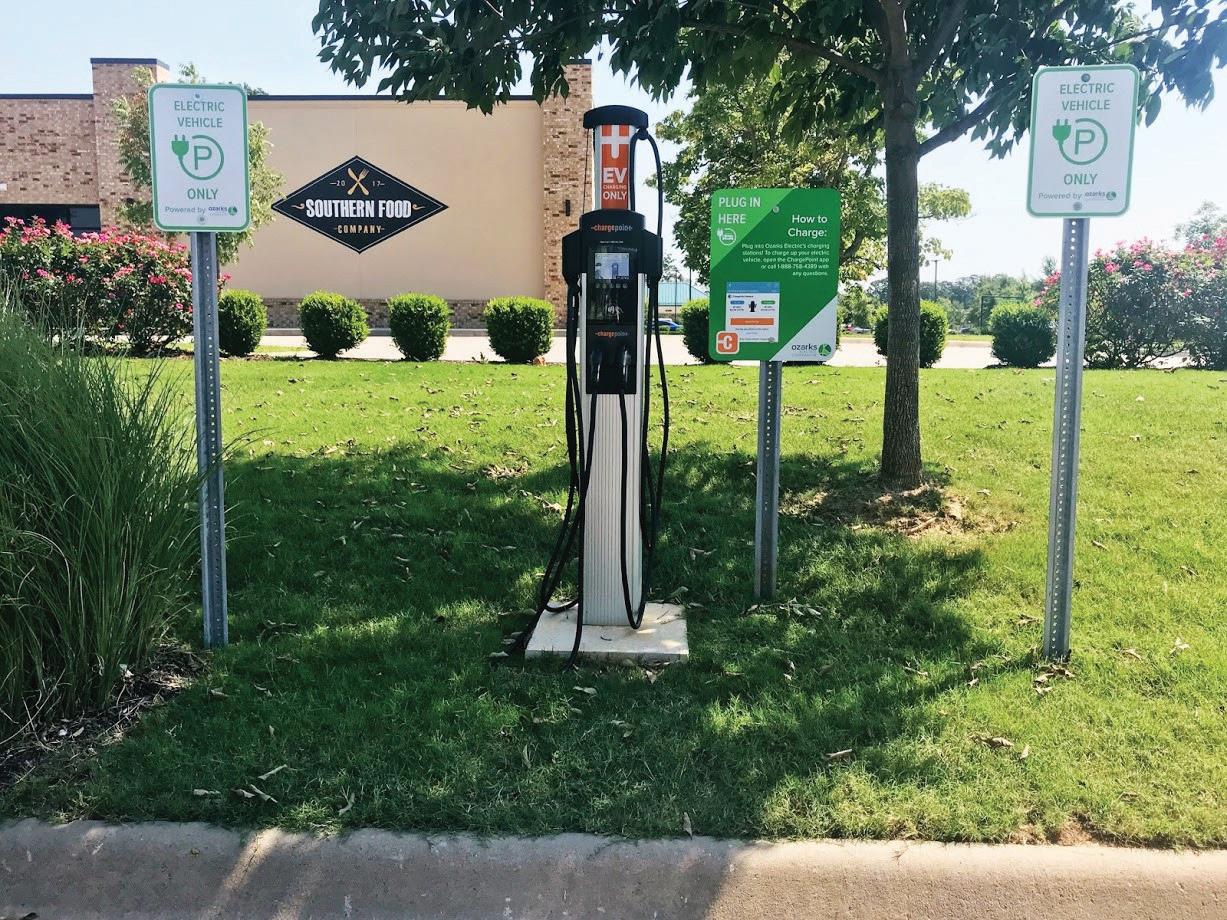





Entergy Arkansas is investing today to power a brighter future for our customers. Clean, reliable energy is not only vital to the safety and comfort of every Arkansan, it fuels industry and our economy. Together, we power life.
Entergy is the largest solar power provider in Arkansas with more than 3,500 acres of solar arrays currently operating or under development. Together, our facilities will provide enough clean power to energize more than 61,000 homes.





We are improving reliability and customer service by upgrading our critical infrastructure and installing new advanced meters, giving customers more confidence and control at their fingertips.
We have been serving Arkansans for more than a century, with nearly 2,800 employees and over 700,000 customers. We’re honored to have been named the 2020 “Best Company in the State” by Forbes.com, and a Top Economic Development Utility by Site Selection magazine.
Learn more at entergyarkansas.com/brightfuture
 By Angela Forsyth
By Angela Forsyth
Whether for cost, environmental
concerns or a need to comply with regulations, many businesses are focusing on reducing their energy consumption. And while acting environmentally responsible is its own reward, business owners have also found that taking steps toward becoming more energy-efficient can improve their company’s bottom line — especially if they focus on installing or updating their HVAC systems. As more businesses improve their energy usage, the hope is that the state of Arkansas will become a bigger participant in the role of energy conservation.
According to the U.S. Department of Energy (DOE), the major areas of energy consumption in commercial buildings are heating, ventilation and air conditioning. During peak hours, the three account for 41 percent of total building energy: heating, 3 percent; cooling, 22 percent; and ventilation, 16 percent. The DOE also noted in 2018 that buildings are the single largest energy-consuming sector in the U.S. economy, representing
approximately 75 percent of the nation’s electricity use and 40 percent of its total energy demand (U.S. Energy Information Administration 2018).
When it comes to energy efficiency, Arkansas has average rankings. Sierra Club Arkansas Chapter Director Glen Hooks calls the state a “mixed bag.” The American Council for an Energy-Efficient Economy (ACEEE) ranked Arkansas 33rd in terms of effective energy-efficiency policies in the 2020 State Energy Efficiency Scorecard, the same position it held in 2019. However, the state scored a half-point less than in 2019, earning 13.5 points out of a possible 50. Hooks noted that utilities are performing well, spurred by state targets and incentives, but too many large industrial energy users are opting to not participate.
“Energy-efficiency measures are often thought of as the least ‘glamorous’ area of sustainability but are incredibly important,” Hooks said. “The cheapest energy ever produced is the energy we don’t need to produce at all. Energy efficiency is the safest, cleanest and most affordable way to meet energy demand. Utilities that do not vigorously pursue efficiency are put-
ting the interests of profit and shareholders before the needs of their customers.”
Powers of Arkansas CEO Alan Hope shares a similar view: “The cheapest kilowatt hour is the one you don’t use.” As the leader of the largest privately held HVAC/controls/service company in the state, Hope acknowledged that solar and other renewable energy sources are valuable on the production side but is certain that implementing Building Automation and Control (BAC) systems is a more effective route towards energy efficiency.
Hope said BAC systems can manage a commercial building’s energy use in a way that reduces its need for kilowatt hours in the first place. Modern BAC systems work to cut heating, cooling, lighting and other energy costs while still maintaining proper comfort levels for residents or workers.

Finding energy efficiency through BAC systems is not a new concept. Powers worked with the University of Arkansas for Medical Sciences several years ago to add 1.4 million square feet of conditioned space without increasing its energy footprint, thanks in part to BAC systems and energy-efficient equipment. According to Hope, the project continues to save tax dollars “while keeping patients, students and employees comfortable.” And Powers continues to work on similar projects across the state.
Energy savings and consumption will always be a moving target, but the hope is that society will continue finding ways to conserve energy that benefit the environment and businesses at the same time. According to a recent report from E2, Arkansas has thousands of jobs directly related to energy efficiency.
“These are the kinds of good-paying jobs that cannot be outsourced,” Hooks said. “Arkansans are weatherizing homes and businesses, installing energy-efficient appliances and generally improving the quality of life in our communities.”
Hope is optimistic about the state’s
outlook in terms of energy efficiency, noting that even though there is room for improvement, the systems and equipment available today are far more efficient than a decade ago.
“We have a lot of architects, engineers, developers and building owners and managers who work every day to raise the bar,” Hope noted. “All you have to do is look at the number of LEED-certified
facilities that have come online in recent years.”
There always will be more work to do in terms of energy efficiency, Hope said. He stressed the importance of incentivizing full participation from all businesses, along with modernizing building codes and fully embracing electric vehicles and infrastructure. The business climate is good, he said.
Headquartered in Little Rock, Powers of Arkansas is currently designing, installing, upgrading and servicing more than 100 Building Automation and Control (BAC) systems across the state. The BAC projects serve a variety of clients including health care, higher education, K-12 schools, commercial buildings, industrial facilities and government buildings. And similar to the work done with UAMS, other large buildings are upgrading air heating and air conditioning without increasing their energy footprint.
In completing these considerable projects, Powers is expected to create a dramatic impact on energy usage across the state in the coming years. In addition to current BAC work, the company has other large projects ahead. One includes a project for Baptist Health. Another is with Crystal Bridges Museum of American Art, which is in the design phase of an expansion.
With more than 45 MW of solar under development in Arkansas, Entegrity is proud to be a full turnkey solar provider. Bringing decades of energy experience to design, finance, build, and operate projects, our inhouse team works to ensure each project creates savings for years to come.

After more than 70 years, we’re proud our name is still synonymous with integrity. Our family has grown to include many Nabholz team members, whose hard work has cemented our reputation in the construction market.

1.877.NABHOLZ | www.nabholz.com

Gain competitive advantage in any job market by adding a skill set that combines technical, business and managerial expertise with a Harding University Master of Science in Information Systems.

• 100% online
• Equips business professionals in data analytics, information security and project management
• Emphasis in ethics in technology, critical thinking and problem-solving techniques
Customized physical, occupational and speech therapy programs are conducted by licensed therapists who focus on improving mobility and motor skills following an injury or illness. The enrichment of daily physical function can significantly improve a resident’s selfreliance and overall happiness.
Our staff provides residents with specially tailored treatment plans designed to recapture health, independent living and facilitate a return home.

Jamestown features separate rooms and private suites with a private entrance for the comfort and convenience of shortterm residents and their families focused on returning home. A full meal service with snacks is prepared daily.




For more information, please visit harding.edu/msis

our line is spooled, rods all accounted for, and your tackle box restocked. Your bobbers, weights and lures are all organized to the color. There might have been some winter-weather-induced boredom behind that Marie Kondo-esque tidiness to your tackle, and things may not look that neat by summer’s end, but either way — the time has come to put it all to good use. To cast your line and try to land a hook in what lurks beneath the water’s surface.
But just as polarity and superstition can surround the bait and artificials of preference, so too can it encompass one of the most important decisions of all: where to fish. Here are a few of our favorites, broken down by species.
Like with trout, the Natural State is well-known for its ample and sizable population of walleye. And also like trout, walleye are cool water fish, commonly found in streams, rivers, clean lakes and tailwaters.

LAKES
- Bull Shoals Lake
- Greers Ferry Lake
- Lake Catherine
- Lake Greeson
- Lake Hamilton
- Lake Ouachita
- Lake Norfork
RIVERS
- Black River
- Current River
- Eleven Point River
- Kings River
- Spring River
- White River
Many anglers consider the crappie as the hidden gems of the fishing world, so to speak. Not only is the species one of the best-tasting freshwater fish around, it generally takes a little more work to find. However, crappie typically congregate in schools, so once tracked down it’s bound to be a productive day on the water.


LAKES
- Beaver Lake
- Bull Shoals Lake
- Cane Creek Lake
- Lake Conway
- Lake Dardanelle
- Lake Greeson
RIVERS
- Mississippi River
- Spadra Creek
- White River
State Record
22 pounds, 11 ounces; Greers Ferry Lake (1982)*
*Also the 12-pound-line-class World Record.
- Lake Overcup
- Nimrod Lake
The state is probably most renowned to visitors for its abundant trout fishing opportunities, thanks in large part to the fisheries developed over the past 50 years by the Arkansas Game and Fish Commission (AGFC).

TAILWATERS (DAMS)
- Norfork Lake
- Bull Shoals
- Beaver Lake
- Lake Ouachita
- Greers Ferry Lake
STATE RECORD
RIVERS
- Little Missouri River
- Little Red River
- Spring River
- White River
• Cutthroat Trout: 10 pounds, 2 ounces; White River (2018)
• Lake Trout: 11 pounds, 5 ounces; Greers Ferry Lake (1997)
19 pounds
1981
64 pounds, 8 ounces
StateReco rd Striped B a ss
• evaeB r ekaL
2000
Arkansas also has a very good track record when it comes to bass fishing, especially largemouth bass. The species is very available practically anywhere in the state, but a few spots can churn out bigger splashes than others. And as the warmer weather turns the clock on the largemouth’s return to shallower waters, this time of year is perfect for anglers.

TAILWATERS (DAMS)
- Beaver Lake
- Bull Shoals Lake
- DeGray Lake
- Greers Ferry Lake
- Lake Chicot
- Lake Conway
- Lake Dardanelle
- Lake Greeson
- Lake Millwood
- Lake Norfork
- Lake Ouachita
- Mallard Lake
- Table Rock Lake
If crappie is among the most delicious fish to eat from Arkansas’ waters, then catfish have just as much a case to make on that front. (Which is best probably comes down mostly to personal preference.) Catfish is also one of the largest game fish in the state and among the most plentiful species as well.
TAILWATERS (DAMS)
- Degray Lake
- Greers Ferry Lake
- Lake Atalanta
- Lake Conway
- Lake Greeson
- Lake Hinkle
- Lake Millwood
- Lake Ouachita
- Lake Wilhelmina
- MacArthur Park Lake
- White Oak Lake
RIVERS
- Arkansas River
- Little River
- Mississippi River
- St. Francis River
- White River
STATE RECORD
• Blue Catfish: 116 pounds, 12 ounces; Mississippi River (2001)
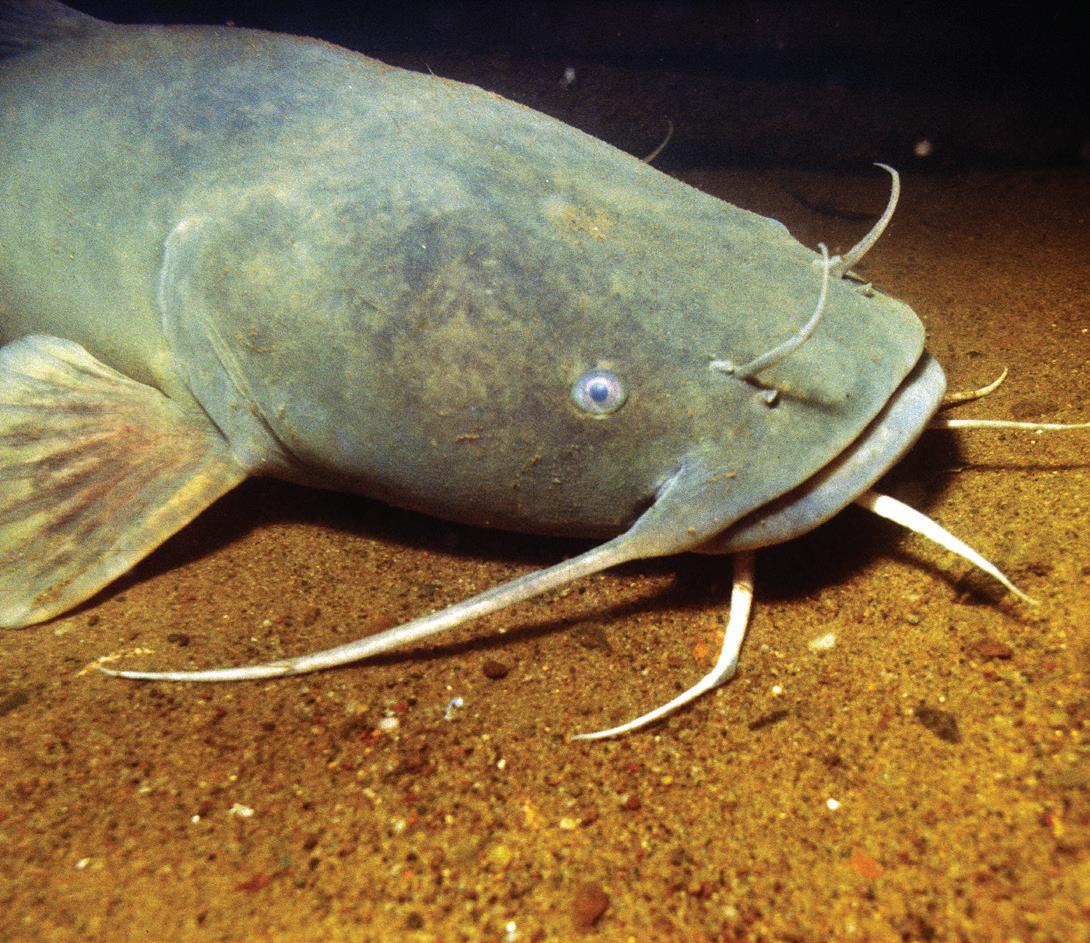
• Channel Catfish: 38 pounds; Lake Ouachita (1989)
80 pounds
1989
RIVERS
- Arkansas River
- Buffalo National River (smallmouth)
- Cossatot (smallmouth)
- Little Red River (smallmouth)
- White River
STATE RECORD
• Largemouth Bass: 16 pounds, 8 ounces; Mallard Lake (1976)
These are just a handful of the items that Arkansas Money & Politics readers say they keep closeby and in mind during severe weather season.
3 Bicycle helmets
3 Identification
3 Power banks
3 Generators
3 Insurance
3 Storm shelters
While many businesses were left devastated in the wake of the COVID-19 pandemic, one business market that was unscathed in terms of need was the severe weather preparedness-and-recovery business.

Since 2012, Arkansas has experienced the wrath of 265 tornados causing a total of 22 fatalities and 308 injuries. These injuries and deaths were caused by flooding, high winds and straight-line winds, debris, hail and lightning. Victims over the 10 years have ranged in age from infants to 76.
Every year, tornado-producing severe weather has be-
3 Pet crates
3 Flashlights
3 Bottled water
Wcome increasingly worse in the Natural State, with 2020 proving to be the worst year for tornadoes to date, according to Dennis Cavanaugh, a meteorologist with the National Weather Service office in North Little Rock.
“In 2020, Arkansas had 45 official tornadoes, the strongest of which was an EF3 that left Jonesboro shaken in late March,” he said.
Cavanaugh spends many weekends and evenings training and equipping the public with the tools needed to be an informed storm spotter. Cavanaugh currently serves as the Warning Coordination Meteorologist for the National
Weather Service, but he started his career in 2005 as a forecaster in the NWS weather forecast office in Topeka, Kansas. He moved on to be a lead forecaster at the Dallas/Fort Worth office before joining the Little Rock forecast office in January 2016.
As of the first of May, Arkansas had seen three tornadoes in 2021, but the state’s yearly average is 33. However, May is the height of tornado season, and Arkansas is settled in a tornado-prone region.

As tornado season approaches, and with storms worsening over the last decade, the business behind severe-weather preparedness has significantly increased.
In 1999, Jim Garner sat attentively in front of his television outside of Cabot, hanging on to each word the meteorologist uttered. An F3 tornado was just beginning what would become an eight-mile path. It was 1,000 yards wide and would go on to do hundreds of thousands of dollars worth of damage and kill several people including a 2-month-old infant. But at the moment, a likely tornado looked to be headed for his house.
Garner’s wife at the time was gone with the only vehicle, so Garner called his brother, Don. But Don was some ways away, and damage already done in the area made it hard to traverse the rural roads. Garner had no choice but to wait out the storm. Miraculously, the tornado went over Garner’s house, on its way to barrelling through the southwest side of Beebe, but the feelings of fear and helplessness had branded themselves into Garner’s mind. Later that year, he founded Cozy
Caverns Storm Shelters, which now has offices in Cabot, Austin and Ward.
“After that I thought, ‘No, I’ve got to have a storm shelter.’ A friend and I found these fiberglass ones over in Oklahoma. And we drove out there one day to look at them, and we saw all these steel storm shelters sitting around,” Garner recalled.
He said the steel models were far more efficient than their older counterparts.
“I’m used to the big hump-in-the-yard eyesores. But these new steel ones were really cool. So, me and my brother both bought one and put one in the ground. And I started thinking, ‘Well, if we both wanted something better, you know, for the protection of our family, maybe others might too.’”
Garner returned home and assembled a group of welders, who took their basic idea of steel storm shelters and widened the staircases while adding more benches and more structural support. The staircases in Garner’s storm shelters are offset





As tornado season approaches and with storms worsening over the last decade, the business behind severe-weather preparedness has significantly increased.Cozy Caverns shelters have made it as far as California. An EF4 tornado in Manitoba in August 2020. A Cozy Caverns shelter following a tornado that rolled through Vilonia.
from the main rooms so they don’t take up any room inside the shelter. They also have non-slip tape with a glow-in-thedark, reflective yellow strip to guide customers inside.
The shelters have bench seating around both sides and across the back, along with a safety handrail and a 14-inch turbine. Garner has sold more than 950 just in Arkansas and has sold to customers in 25 states since 1999. He continues to improve his models as people offer insight and advice, such as the improvement of handicap accessibility. His storm shelters have been in high demand, and Garner said that he is currently working through 14 weeks of backlog. Plus, he plans to offer above-ground safe rooms at some point in the future.
“I don’t want to have extra help because that can sacrifice quality. We tried that one time, and we were having to go back and fix their mess up. So, I just decided it’s best to keep our own quality people,” Garner explained. “And if people have to wait a little bit longer, it’s because they’re getting the quality of shelter that I want to provide and what they’re actually looking for.”
With over 20 years of storm-prevention business expertise, Garner has been able to make a few observations.

“Our orders normally pick up around
February and go on through almost August now,” Garner said. “As far as the weather and tornado activity, I think the weather and tornado alley has moved over to the east more. In fact, Arkansas is right dead-center now — it’s not so much in Oklahoma as it used to be.”
Garner also has observations about his customer base.
“Our customers’ age span normally is between 30 and 50 years old,” he said. “For the most part, I think the younger generation has yet to maybe get the full effect and see the devastation that a tornado can do, and I think the older people have the feeling that they’re invincible now that they’ve lived this long.”
Maria Hahn, the business development and sales director with STORMBOX, a storm preparedness company covering the southeast, made similar statements.
“Over the last decade we have seen a significant increase in storm occurrences and severity. This increase has created a noticeable uptick in the market of storm shelters and, as such, has driven a need for more standards within the industry to ensure quality of products,” Hahn said. “Naturally the market surges in spring as we face tornado season and in summer as we go into hurricane season. After these seasons pass people tend to put storm
Devastating tornadoes, like the one that hit Joplin in 2011 (left and far left), usually lead to a spike in storm shelter sales.

safety on the back burner since the immediate need is not as great, but we would all be better served if the planning was year round.”
Alisa Smith is the sales manager with Tornado Shelter Systems Inc. in Beebe. The company was founded when her husband, Jim Smith, purchased the manufacturing business from a good friend and began Tornado Shelter Systems with their sons 14 years ago. Smith firmly believes that action should be taken by all Arkansans to prepare for severe weather events.
“You should not lose a life because of a tornado,” Smith said. “We see this as a service company for our state.”
Tornado Shelter Systems sells aboveand below-ground storm shelters and panic rooms, complete with bulletproofing if needed. The company uses steel from Nucor, an Arkansas-based company. Smith sees various motivating factors in her sales.
“Older people usually have more income and will see the value. Younger couples with children see the value in the above-ground shelters because they can take the shelters with them should they
move, so it can be a one-time purchase since they last forever,” she explained. “The above-ground shelters can also be used for clients in wheelchairs.”
She noted that the above-ground shelters are also used by rural clients who don’t have access to public shelters and clients with elderly or disabled people in their homes.
Smith emphasized that regardless of whether customers are urban or rural, young or old, more and more Arkansans are taking notice of the shifts in severe weather.
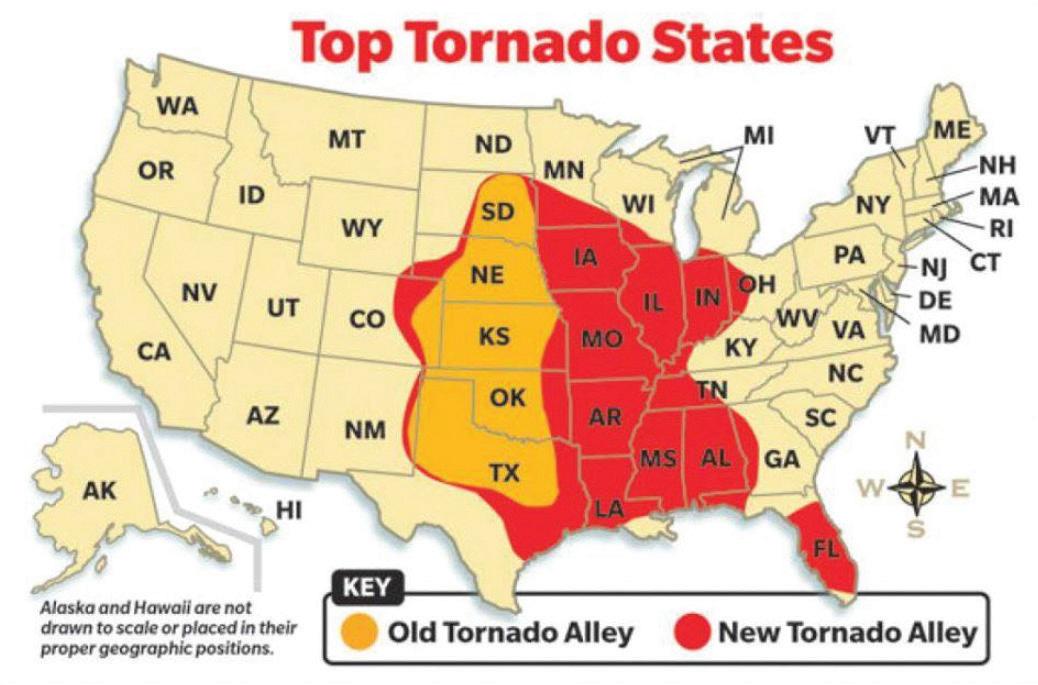
Of course, more severe weather patterns have led to an increase in the repair business as well.
Chris Brimhall is the property manager with Farm Bureau Mutual Insurance Company of Arkansas. Farm Bureau was founded more than 70 years ago, and its insurance companies are among the largest writers of property and casualty insurance in the state. Insurance products that the company provides include home, auto, farm, inland marine and general liability insurance. But over the last decade as storms have intensified, Brimhall said some areas of business have picked up

Before and after shots from Joplin in 2011 reveal the destructive power of tornadoes.

more than others.
“Over the last decade, we’ve seen an average of five severe-weather events per year with losses in excess of $3 million each,” Brimhall said. “We saw seven such events in 2020 and have experienced three so far this year.”
Brimhall said he’s noticed a variety in precautions taken, depending on where customers live.
Rural areas tend to have more standalone, in-ground storm shelters due to older homes and older residents. Urban areas with younger residents and newer construction tend to have more safe rooms and storm shelters built into garage floors, he said.
Brimhall noted that the reasons people invest in storm shelters run the gamut from protection against severe weather to prior experience with tornadic events, as well as the increased number of severe weather events, newer cost-effective options and an increase in property value.
As weather becomes more severe in the Natural State, it’s crucial that Arkansans have a plan long before the skies get dark. This means preparing before the storm so less time is spent repairing after it.
Jim Garner, Cozy Caverns Storm Shelters:
• “If you think there’s going to be severe weather, keep your ear on the radio and your eye on the radar. Stay at home, but if you happen to be outdoors and in the path of a tornado, get in a ditch and cover your head. Additionally, it would be worth investing in a football helmet for your severe weather kit. Know where your public shelters are and use them,” Smith advises.
• “People try to go out and about if they think there’s going to be severe weather. Many people try to take shelter in department stores when severe weather hits. But you’ll notice that there are a lot of structural beams that hold the roof up. This, and an overpass, are two of the worst places to be.”
Chris Brimhall, Arkansas Farm Bureau:
• “Don’t take any chances. Don’t go outside just to ‘take a quick look.’ Stay away from windows, and don’t try to leave in a vehicle.”
• “People say to go to the southwest corner of the house, but this isn’t always the best answer.” Other pieces of bad advice include opening windows to ‘relieve the pressure’ in the house, taking shelter under an overpass and trying to outrun a tornado.
ARKANSAS SEVERE-WEATHER EXPERTS SHARE THEIR TIPS OF WHAT TO DO AND WHAT NOT TO DO IN THE EVENT OF A TORNADO WARNING.
 By Katie Zakrzewski
Service
By Katie Zakrzewski
Service
When it comes to flight school and training civilian pilots, students and Arkansans alike have turned to Central Flying Service in Little Rock for direction. But the history of Central Flying Service is intertwined with rich political, military and economic influence.
During the onset of World War II, the United States had developed an isolationist policy — by refraining from a European war, the United States could continue to improve its own economy through unfettered trade.
But President Franklin D. Roosevelt could see war on the horizon, and America was very deficient in pilots. To combat the pilot shortage, Roosevelt created the Civilian Pilot Training (CPT) program. Under this program, the U.S. government would pay for citizens to learn to fly. A federal task force began to determine which companies and higher education institutions would get the contracts to
participate in the program. Little Rock Junior College, known now as the University of Arkansas at Little Rock, received one of the grants. Once the grant was received, flight training was then assigned to the company.
In 1939, aviation pioneer Claud Holbert, along with a close friend who was a fellow national guard officer, formed a company called Central Flying Service in order to bid on the CPT contract. And they got it.
Central Flying Service began as a flight school under the program, and when the United States got involved in World War II, all the CPT programs
were converted into war-pilot training programs.
By the end of the war, Central Flying Service had established itself as a reputable one-stop avionics shop. Richard Holbert, chairman and CEO of Central, said by that time, the company was established.

“We were selling airplanes, chartering airplanes, as well as conducting flight training. We are the state’s oldest aviation firm that is an Arkansasbased company,” he said.
For a military family like the Holberts, service to the United States has always played a pivotal role in the
company. Richard and his brother, Don, were both in the Army. Richard was discharged in 1972, and his brother was discharged in 1968.
Although his father, Claud, passed away in 1983, Richard had taken up his father’s mantle as president of the company in 1981. Claud’s daughter-inlaw, Susan Holbert, is the company’s current president.
Prior to 2015, when Central Flying Service sold its leasehold at Adams Field in Little Rock to TAC Air, the company had been the largest fixed-base operation in the world, measured by square feet under roof. A fixed-base operation is one that is granted the right by an airport or aeronautical facility to operate on the property and provide aeronautical services. This concept was preva-
lent in the years following World War I, when there were a plethora of airplanes and civilian pilots, but no permanent locations where services could be performed.
During the 1950s, Central Flying Service was a force to be reckoned with in the avionics industry, and bigname people were starting to notice.
“When Winthrop Rockefeller came to Arkansas in the early ’50s, my father was his personal pilot. Now, he wasn’t employed by him directly, but Central Flying Service provided pilot service, which in that case was my father,” Holbert explained. “Rockefeller was a great customer of ours. We sold him his airplanes.”

This connection to Rockefeller — who in 1967 would become the state’s first Republican governor since Re-
construction — would turn out to be pivotal not just in Holbert’s life, but in the political life of Central Flying Service.
In 1965, Holbert’s father and the usual pilot were both busy on the days that Rockefeller was set to travel to Washington, D.C. The pilot needed someone to co-pilot, and that co-pilot was Richard Holbert.
“I fit the bill and ended up going to D.C. It was the first time I’d ever been to D.C., and it was the first time I’d ever been in a private jet,” Holbert recalled with a laugh. “And I got Potomac fever.”
Holbert described how he fell in love with Washington, D.C., but was sobered by the realization that he would be continuing law school in Fayetteville. Regardless, Holbert de-
cided that he would take the next few days to catch up with friends.
“I had just graduated from Fayetteville and was about to start law school. I was enrolled at Fayetteville because that was automatic,” Holbert recalled.
“But I had some friends who were working for [U.S.] Senator [William] Fulbright at the time, so I went by to see them. They asked why I wasn’t going to school up here, and I said that I couldn’t afford it. They said that they
would get me a job.”
What happened next is what Holbert considers a stroke of great luck.
“We went down the hall and met with Lee Williams, who was Fulbright’s administrative assistant at the time. And then he told me to go to school up here, and that he’ll give me a job. I ended up going to law school at Georgetown, and then I went into the Army after that.”
Holbert spent the next several years working for Fulbright, and during the 1974 campaign, Fulbright held campaign conferences in the lobby of Central Flying Service. One of the notable politicians who attended these campaign press conferences was then U.S. Secretary of State Henry Kissinger.
Soon enough, Holbert said, “All of the important people who came to Little Rock came through Central Flying Service.”


Many governors, congressmen and senators began to travel through the charter services offered by Central Flying Service. Former Arkansas Gov. Dale Bumpers was considered a regular. Central also hosted 1972 presidential candidate George McGovern just prior to election night.




“It was Nixon versus George McGovern, and Nixon was going to wipe him out. It was apparent. So… George McGovern had a rally in this hangar,” Holbert said. “He might not have gotten many votes, but the hangar was full. We always thought that it was interesting that he spent [that] night here in Little Rock, Arkansas.”


Another notable politician who visited Central was former President Ronald Reagan, who made an impression on his last stop in 1988 campaigning for Republican candidates.
“Ronald Reagan was here several times, and [on] one of them, he brought Air Force One right up on the tarmac, and they built a scaffolding. He got right on the scaffold and gave his talk.”
In the years since, big-name corporate leaders have flown through Central for economic summits, while celebrities such as Robin Williams and Barbara Streisand used the company when they came to town for the Clinton Presidential Library’s opening
celebration.
Even today, Holbert says Central has been weathering the upheaval caused by the pandemic through its partnerships with universities.
“We have a contract with Liberty University. They have about 25 operations around the country where they have their online students who are in their aviation degree program take the fight training,” Holbert explained. “So, we do the flight-training portion of the curriculum for students who are enrolled at Liberty. From 1982 to 1992, we did flight training for Henderson State University as well as Ozarka College and Pulaski Tech. But those aren’t the only people we teach — we teach
anybody.”
The walls in the testing room at Central Flying Service are covered from floor to ceiling in T-shirts with names, slogans and designs. The shirts all belong to pilots that Central has trained.
A glance around the room reveals that Central Flying Service still embraces the vision and ideals Claud Holbert brought to the company he created in 1939.

That tradition has been carried on through his family. For decades, Central Flying Service has remained an integral part of the world’s air-transportation system and likely will be for decades more to come.

During the 1950s, Central Flying Service was a force to be reckoned with in the avionics industry, and big-name people were starting to notice.An aerial view of Adams Field with Central visible in the upper left (top); a 1980s-era Soviet MiG fighter plane made its way to Central Flying Service (bottom left).

Sam Alley, CEO of VCC in Little Rock, knows a little something about what makes people tick and how to spot talent.
As a teenager immigrating from outside Jerusalem to Rose City, Arkansas, he learned that similarities within people far outweigh differences in culture, language and skin color. As CEO of the largest retail contractor in the United States, he refined his process for sizing up talent and putting people to work in the right roles to move objectives forward. And as a businessman, he’s at his best when evaluating opportunities, based on the people behind them.
One key weapon in his arsenal for achieving all of this: the golf course.

“Golf, first and foremost, is an effective friendship tool,” he said. “There are few better ways to get to know someone intimately than to spend time on a golf course together. Many of my best friends from across Arkansas, the country and the world have come through the game of golf.
“And a great truth of the work environment is that great friendships can lead to fruitful business relationships over time. So, yes, I think golf is a wonderful way to get personal and professional fulfillment with people you enjoy being around.”
Moreover, Alley said, the game follows an old idiom, attributed to John Wooden: “Sports do not build character; they reveal it.”
“On the course, you will learn more about people and their risk-reward decision making,” he said. “You also can observe how they follow the rules of the game. It reveals a lot about someone’s character and how they may approach real-life situations.”
For a sport that’s been around for 500 years, golf is looking mighty sprite these days. A game that’s survived wilder swings than a 15-handicap duffer in a pot bunker has been on a tear lately, staging a comeback that has to be seen to be believed.
Following April 2020 when rounds were down a quadruple-bogeyesque 42 percent due to COVID-19, the game charged from behind during the rest of the year, per a January 2021 article in The Wall Street Journal. Rounds finished up 14 percent for the year with December rounds alone up 37 percent. Numbers published by the National Golf Foundation showed rounds played in its South Central Region (Texas, Oklahoma, Arkansas, Mississippi, Louisiana and Alabama) were up 33.5 percent and still only middle of the pack among the NGF’s eight regions.
“In 2020, we had more rounds of golf than we’ve had in over 10 years,” said
at all, and that has carried over into 2021. We’re still showing an increase in rounds played.
“If it carries on like the first quarter, it’s
golf courses surveyed by the NGF said they were in “poor” or “very poor” financial condition, worse even than in the aftermath of the 2008-2009 financial crisis.
The situation had stabilized by the start of 2020 when only 8 percent of public courses reported similar conditions and the percentage reporting being in “good” or “great” shape had doubled.
The set-in of the global pandemic, devastating in March and April, was ultimately an unexpected accelerant to that momentum.
In addition to rounds played, Auerbach said the number of lessons and memberships have been similarly bullish, as PVCC closes in on 1,000 members for the first time since perhaps the 1970s, he said.
going to be a great year. It’s pretty much holding strong like 2020 as far as rounds played. As the COVID restrictions are being lessened, that’s only helping the game. Our youth programs are totally full. There’s a waiting list for them. Everything looks positive.”
Golf’s popularity, like that of any other activity, has waxed and waned with the times, very often on the backs of popular PGA champions. Arnold Palmer’s “Arnie’s Army” begat the Jack Nicklaus generation and after him, the Tiger Woods tsunami that brought newcomers to the game as never before.
“If you look at it this way, you’re outdoors,” Auerbach said. “We put all these protocols in; we had single riders in golf carts, the flag sticks stayed in the greens, we expanded times in between individual tee times to give more of a space. And this has carried over to now. It has not dropped off at all.”
While golf overall was going great guns, golf-as-networking took it on the chin, Auerbach said. Though golf and business have enjoyed a long and profitable partnership, 2020 made it more about the game and less about the deal, especially as the pandemic restricted the “19th hole” of dining and beverage services where many proposed ventures were consummated.
Michael Auerbach, general manager of Pleasant Valley Country Club in Little Rock. “We did implement a lot of protocols for COVID, but it didn’t slow us down

In between these periods of immense popularity have been lulls that have shuttered courses and closed fortunes. In fact, golf was in the rough as recently as 2016, WSJ reported, when a quarter of public
“In 2020, nobody was doing much business of anything. It was more of an escape for our members to get out and be outdoors,” he said. “You didn’t see nearly what it was as far as business going on, guys trying to make deals and whatnot. It was more, ‘This is my only escape from COVID.’ Now, you can look by the tee sheet and see, well, that’s going to be a business group. That’s starting to pick back up.”
As the COVID restrictions are being lessened, that’s only helping the game. Our youth programs are totally full. There’s a waiting list for them. Everything looks positive.
“Dues income coming in certainly helped us in 2020 to survive. Golf was by far the most profitable end of the whole entire operation. But now, we’re starting to slowly see the food and beverage end pick back up to where it used to be. I’m very confident that 2021 is going to turn out to be pretty good.”
Business conducted on the golf course may have fallen off, but the business of golf courses surged right along with the game’s popularity. NGF statistics show equipment sales reached a record $1 billion in the third quarter of 2020, with on- and off-course equipment receipts 42 percent higher year-over-year. That was followed by the highest December on record, with final-month sales 58 percent over the previous year, which bodes well for future engagement. Such numbers make it easy to forget that just five years ago, Nike shocked the retail word by exiting the golf business, with Adidas cutting way back the following year.


Also in 2020, several equipment manu-
facturers and retailers were stock-market darlings, including Acushnet Holdings, known for Titleist and FootJoy, beating the S&P 500 by 14 percentage points. Dick’s Sporting Goods, owner of Gold Galaxy, beat the market by 32 percentage points and Callaway Golf, rebounding from losing three-quarters of its value in the first
quarter, beat the market by 13 percentage points by year’s end and announced it was acquiring driving-range operator Topgolf.
Moreover, WSJ reported, the number of first-time U.S. players hit 2.5 million in 2019, exceeding the previous high of 2.4 million in 2000 at the height of Tiger Woods mania. All of which is music to
the ears of Chris Cerrato, who with his son recently opened Heights Golf.
“I’m a business guy, and I do play a lot of golf, play in a lot of tournaments and take customers to those tournaments,” Cerrato said. “My son, Casey, and I play all the time, and one day we were sitting there and he goes, ‘Why isn’t there a golf store in the Heights?’
“I said, ‘I don’t know, seems like a no-brainer.’ You think about the per capita income in that area, there’s a lot of golfers, there’s the Country Club of Little Rock, it’s kind of inbetween Rebsamen golf course and Pleasant Valley. It’s just a big golf area. Three months later, he and I opened a golf shop.”
Cerrato, who is also president of Evo Business Environments, said the golf store has been at a dead run since it opened in November. While a majority of patrons tend to be men, the store sees a surprising number of families. A lifetime player himself, Cerrato sees golf as more popular than ever.
“One thing we did not anticipate when we started our store was the demand for golf has gone up a lot during the


pandemic. Trying to get equipment was our biggest issue,” he said. “We were able to do our renovation pretty quickly for the shop, but it was tough getting product in.
“We were welcomed pretty openly by some of the big golf manufacturers, but a few were hesitant because we were just a store and not a big name. They were so slammed, we had reps bringing us product in their cars from other stores, so that should tell you the demand for golf during this pandemic. Everyone is wanting to do more recreational and outdoor things, so I think golf is here to stay.”
The golf course construction industry is similarly optimistic even though its financials were more modest than that of rounds or equipment. Patrick Schueck is president and CEO of Little Rock-based Lexicon Inc., a subsidiary of which Heritage Links is one of the leading golf-course construction firms in the country. He said the Houston-based holding company enjoyed a full slate of projects last year, and signs point to more to come, both here and abroad.
“Heritage Links is experiencing steady work domestically and is focusing on more international opportunities,” he said. “To date, Heritage Links has constructed or renovated
more than 250 golf courses across the U.S., including the soon-to-be headquarters of the PGA America at PGA Frisco, Texas.
“We’re leaving our mark on an industry that’s grown approximately 16 percent in the last year alone. From our home state to PGA Frisco, Liberty National and the Robert Trent Jones-designed Chambers Bay in Washington state, Heritage Links is meeting Lexicon’s long-standing mission to ‘Build America.’”

Schueck said the challenge for the future isn’t necessarily in landing more work, but attracting the required labor to complete the work that’s out there.

“COVID-19 encouraged people to get outdoors and take up safe, enjoyable activities like golf,” he said. “Projects like PGA Frisco and the commitment and initiatives PGA of America have in place will make the sport even more accessible to individuals of varying skill and socioeconomic levels. While we explore these new growth opportunities, we also plan to diversify our projects into other outdoor sports-field areas.
“We are fortunate to have a seasoned, agile team but as more opportunities present themselves to us, we still are challenged to recruit new employees. Once on board, however, we feel confident we can provide the on-the-ground training and mentorship to prepare the next generation of builders.”
Golf Course Industry magazine reported last summer that

while 70 percent of its members had projects canceled last year, almost 40 percent said they expected things to return to normal or increase after the brunt of COVID, compared to 9 percent that worried things would not return to prepandemic levels. This across-the-board optimism comes from courses large and small, from the most iconic links to small neighborhood munis.
For Cerrato, a native of Sherwood who learned the game on public courses and still favors such tracts, that’s the best news of all both for both pleasure and business.
“My dad started playing when I was probably 10. I’ve never really taken it super-seriously and tried to get really good at it. I’m just one of those average players, some years I’m better than others,” he said. “My dad was a blue-collar pipefitter, so I’m not a member of a country club and never have been. My favorite course is Rebsamen, it’s a great usable course, and we played on War Memorial until they shut it down. We’ve got plenty of good golf courses around here.
“There’s nothing like spending four or five hours with somebody that you kind of know on the golf course because after a few hours, you’re going to get to know them a whole lot better. Typically, smart business people don’t talk about business on the golf course; it’s about the game and enjoying the outdoors and all that. If you share a good time with somebody for that long in a beautiful setting, people are going to remember that later.”
• Blessings Golf Club, Fayetteville • Alotian Golf Club, Roland
• Country Club of Little Rock, Little Rock • Diamante Country Club, Hot Springs Village • Hot Springs Country Club, Hot Springs • Russellville Country Club, Russellville • Conway Country Club, Conway






Storm Fluo
$4,599 MSRP*
$430 Destination Charge*
This 321cc liquid-cooled 2-cylinder engine features lightweight forged pistons and carburized connecting rods, delivering easy to manage power in the low rpm range with strong high rpm power. The extremely light clutch feeling makes the MT-03 even more fun in the city, while its offset cylinders and advanced fuel injection system ensures smooth throttle response.

Richards Yamaha
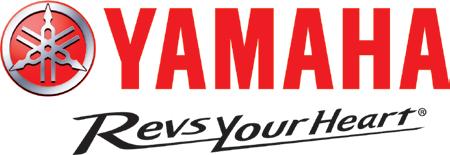
6600 South University Avenue Little Rock 501-562-0910
www.ridearkansas.com



or years, Eric Musselman has been on a text message chain with buddies who go back to his playing days at the University of San Diego in the mid-1980s. In the last few weeks, they had, apparently, essentially dared him to put a clause into his new contract paying homage to his alma mater. Musselman, as competitive as they get, took them up on this challenge, as the sports world recently found out.
In the fine print of his new five-year, $20 million contract is a clause that states that no buyout is mandated if Musselman leaves Arkansas to coach San Diego after April 2024. (If he leaves to coach anywhere else in the 2024-25 season, he’d owe $1 million. San Diego, by the way, is a non-football D-1 school that competes in the West Coast Conference with Gonzaga.)
Musselman said his former teammates are “going to be really happy when they see that, because no one
thought I would actually put that in there or ask Hunter [Yurachek] to put it in there.”
A smile creeping across his face, he continued, “So there’s a lot of burritos that are owed to me when I go back for a three- or four-day vacation in San Diego.”
Razorback fans need not worry, he added.
“This is kind of a nod to the place I went to school, and I don’t think that the University of San Diego is going to be competing with the Arkansas Razorbacks,” when it comes to where Musselman will coach in the prime of his career.
That clause is all fun and games, sure, but the larger question remains: For how many more years will Musselman coach at Arkansas?
If he falls in love with Fayetteville enough, can he become the Dave Van Horn of basketball? Arkansas’ baseball coach since 2003 is among the most consistently successful head coaches ever employed by the

University of Arkansas.
Wess Moore, a longtime sports anchor and now a radio host in Little Rock, sees a few similarities between how the two coaches have begun their Razorback careers.
In 2004, Van Horn, just in his second season, took the Razorbacks all the way to the College World Series — the “Elite Eight” of college baseball. Similarly, Musselman led his group of Razorbacks to the Elite Eight in only his second season in charge.
Granted, there are differences in that Van Horn is an Arkansas graduate who met his wife at the school, while Musselman is from the west coast. Still, Moore asked his Buzz 103.7 FM listeners, “Could Musselman be an Arkansas coach who’s going to be here for 15 years? Do you see that? Do you allow yourself to think that far ahead?”
It’s quite a thought. At 56 years old, Musselman hasn’t coached in any one place for longer than four years since the 1990s.
In the increasingly high-pressure world of college basketball and football, coaches don’t tend to stick with programs as long as they do in baseball, where the money — and pressure — isn’t quite as high. To last as long as 15 years, Musselman will have to avoid long dry spells when it comes to NCAA tournament success. So far, that looks unlikely.
Musselman returns what should be a loaded team in 2022, replete with at least three high-powered incoming transfers.
Musselman will also need to stay content enough with Fayetteville to avoid leaving for other programs. A place like Kentucky or UCLA, for instance, could be a serious threat in coming seasons if those jobs open up. When it comes to sticking with the Razorbacks in future years, a big factor will likely be the relationship between Musselman and Yurahcek.
So far, it’s been great — an exact 180 from the dynamic between former athletic director Frank Broyles and Nolan Rich-
ardson, the last Razorback basketball coach to achieve this much success. Richardson lasted 17 seasons at Arkansas before things disintegrated (to put it mildly) at the end.
Van Horn, too, is now in his 18th season.
For Musselman to make it that long in today’s ever-changing coaching climate would be a small miracle. But sometimes folks tire of seeking greener grass and decide to stick with a good thing once they find it.
Stranger things have happened.
1. Glen Rose, 23 seasons (1933-1942; 1952-1966)
2. Nolan Richardson, 17 seasons (1985-2002)
3. Eddie Sutton, 11 seasons (1974-1985)
4. Mike Anderson, 8 seasons (2011-2019)
5. Eugene Lambert, 7 seasons (1942-1949)
1. Francis Schmidt, 83.7% (113 wins, 22 losses)
2. Eddie Sutton, 77.6% (260-75)
3. Eric Musselman, 70.3% (45-19)
4. Nolan Richardson, 69.6% (390-170)
5. Charles Bassett, 68.1% (62-29)
In SEC men’s basketball, Kentucky’s John Calipari is the only head coach who has been at his current school for more than 10 years.
Indeed, the 14 SEC men’s basketball coaches have been at their current schools for an average tenure of 4.86 years. Baseball nearly doubles that. The 14 head coaches in SEC baseball have stayed at their schools for an average of 9.36 years.
Dave Van Horn of Arkansas is one of six SEC baseball coaches with stints longer than 10 years.

Highest winning percentage as Razorback head basketball coachPhotos courtesy of Arkansas Athletics
 T he main lobby at Oaklawn’s new hotel.
DAVID YERBY
T he main lobby at Oaklawn’s new hotel.
DAVID YERBY
“We committed to creating a world-class resort that did not exist in Arkansas.”
ury in Arkansas to a new level: “It will enhance the entertainment experience at Oaklawn, in Hot Springs and throughout Arkansas, which will further elevate our status as a leading tourism and recreation destination.
“We committed to creating a world-class resort that did not exist in Arkansas.”
Oaklawn held the grand opening of its luxury hotel, spa and event center in late April, part of a $100 million expansion project. The eight-story hotel features 198 rooms, including two presidential suites, while the 15,000-square-foot event center provides a 1,900-square-foot stage, a video wall and seating for 1,500 people.
Oaklawn President Louis Cella said the expansion will take lux-
The expansion was announced in 2018, following a state ballot measure that expanded casino gaming in Arkansas, but had been planned since 2014.
Development and construction took place over the past 28 months. According to Oaklawn General Manager Wayne Smith, the development went off successfully despite the unexpected impact of the COVID-19 pandemic.
– LOUIS CELLA
In Hot Springs, the doors are now officially open at Oaklawn Racing Casino Resort’s new hotel.
IN




“It will enhance the entertainment experience at Oaklawn, in Hot Springs and throughout Arkansas, which will further elevate our status as a leading tourism and recreation destination.”



 - Louis Cella
- Louis Cella



As part of the expansion project, Oaklawn is also constructing a new spa center called the Astral Spa. It will feature a needle shower, infrared sauna and a Himalayan salt wall.



Casino gaming has expanded as well with this project. The expanded gaming center has more than 1,500 slot machines and 33 gaming tables, and there is a new High Limits section, which has 80 slot machines, three high-limit blackjack tables, a private outdoor patio and a private bar.
There is also a bar outside the gaming center called the First Turn, as well as a fine dining restaurant called The Bugler. Oaklawn has also added a food court with three different dining options .
During the project, HGB Design of Memphis served as the architectural partner while Flintco of Springdale was the construction contractor.


Arkansas works hard to stay ahead of trends and shape the future. It’s what makes our state one of the best places to do business, anywhere. And it’s why Stephens chooses to do business — across the country and around the globe — from Arkansas.
At Stephens, we enthusiastically support Arkansas businesses, communities, hospitals, schools and other non-pro t institutions. Working side-by-side with our colleagues, we’re committed to making our state an even better place for everyone.

Barry M. Corkern and Company, Inc. is an independent registered investment advisory firm. As fiduciaries, our interests are aligned with our clients’ interests. We don’t recommend commission-based financial products and services. How do you know if your adviser is a fiduciary adviser? Start by asking them how they are compensated and who pays that compensation.


C Contact us to learn more about how “it’s a different relationship” when working with our firm

BCORKERN.COM



To avoid having to go to my high school homecoming, I got a job as the movietheater projectionist in Horseshoe Bend.
My faltering relationship with a girl at school — which began two years earlier at homecoming — was circling the drain, and I didn’t want to prolong the inevitable. Instead of looking forward to moving to the sounds of Donna Summer, Elton John and Fleetwood Mac at homecoming that fall of 1978, we were already dancing the steps of teenage angst and heartbreak.
So, I heard of an opening at the Music Mountain Theater, and I applied quickly. I began training the night before the big dance, learning how to splice previews onto the reels of films and how to switch the two arc-lamp projectors to go from one reel to another with a smooth transition.
Back then, movie companies shipped film on plastic reels in metal containers. Each reel contained about 20 minutes of film. Generally, when adding in previews, a 100-minute long movie would play on six reels, meaning there were five changeovers between the two projectors. A bell would ring indicating there were two minutes before the change.
It allowed the projectionist to fire up the alternate projector and watch for the “cue dots,” the circles that flashed on the right hand of the screen to indicate there were eight seconds before the switch needed to be made.
“It’s complicated. It takes about two weeks to learn this,” said the fellow training me.
“Great. When do I start?” I asked.
“Tomorrow.”
Seemed the trainer, who was also a student at my school, wanted to go to homecoming with my girlfriend. News traveled fast at small schools where everyone knew everyone, and word of our impend-
ing breakup was trending. While others donned their tuxedos and gowns for the big school dance, I got a bucket of popcorn slathered in butter and began what I referred to as my career in show business. I don’t remember that first movie, but it went well enough that I kept the job. Soon, I began running the Horseshoe Bend movies on weekends, holidays and school breaks.
I saw some dogs at the theater. I must have seen Wanda Nevada, the 1979 bomb starring Brooke Shields, five or six times; one night I ran that movie to three customers. One told me he didn’t care what was showing; he just came inside the theater for the air conditioning.
I also ran Malibu High, an awful high school exploitation film, and Goin’ South, a grungy western starring John Belushi and Jack Nicholson.
I showed the Richard Benjamin, Susan Saint James and George Hamilton movie, Love at First Bite, so many times I memorized the script. Later, when I watched it on television, I could tell when the twominute projector bell would ring.
But there were also great films. I ran the Academy Award-winning The Deer Hunter, turning up the sound to ear-splitting levels when the bombs began falling in Vietnam in a jump cut after a lengthy wedding scene to startle the moviegoers awake. And, speaking of the late Belushi, I was able to watch the classic Animal House several times. Once, I mixed up the film reels, showing the fifth reel before the fourth reel. The accident didn’t alter the movie at all, and when I ran the fourth reel after the fifth, the story continued on seamlessly.
A few times, I didn’t turn the projector’s motor on quickly enough, and patrons were treated to a widescreen showing of a 35mm film cell melting. It looked like the backdrop of a Grateful Dead concert.
I held the job until I went off to college
that fall of 1979. It was a decent position, paying the minimum wage of $2.30 an hour while I watched movies, and I had all the popcorn I could eat. I felt grown up with responsibilities. Without me, those three people couldn’t enjoy the cool of the theater and watch Coming Home or F.I.S.T. or Skatetown, U.S.A.
I am a dinosaur when it comes to movie theaters. Times have changed, and the theaters aren’t what they used to be. First, they no longer use the 20-minute reels, evolving from large platters that contained much more film to digital. Theaters also are fading out due to the COVID-19 pandemic. Because of the virus, most theaters closed or showed films to limited capacities for more than a year.
The Regal movie chain shut all 536 of its movie houses in the United States in October, and only a handful of states have lifted all social-distancing seating restrictions in theaters. Movie companies are also releasing films directly to subscriber television services as a result of the virus, letting customers watch them at home rather than going to the theaters.
I’m happily married now, which is a good thing. I don’t think I could find any projectionist jobs to avoid homecomings and other dates anymore. A
Kenneth Heard is a contributor to Arkansas Money & Politics and its sister publication, AY About You, and works for the Craighead County Prosecuting Attorney's office. He had been the Jonesboro bureau correspondent for the Arkansas Democrat-Gazette from 1998 to 2017 and has more than 30 years of experience in journalism. Ken and his wife, Holly, live in Jonesboro and still like watching movies.

A Growing Health System for a Growing Community Innovative Services New Medical Offices





The Conway Regional Neuroscience Center is the only of its kind in Faulkner County and has a proven record of excellence. Neurologists provide comprehensive services to diagnose and treat illnesses of the neurological system, including multiple sclerosis, epilepsy, Parkinson’s, and Alzheimer’s disease. Visit conwayregional.org for more information.
We’re not just growing—we’re growing together.
#conwayregional
Left to Right: Mark Clark, Ph. D, Tim Freyaldenhoven, MD, Ph. D, Keith Schluterman, MD, Regan Gallaher, MD, and Bhavana Sharma, MD